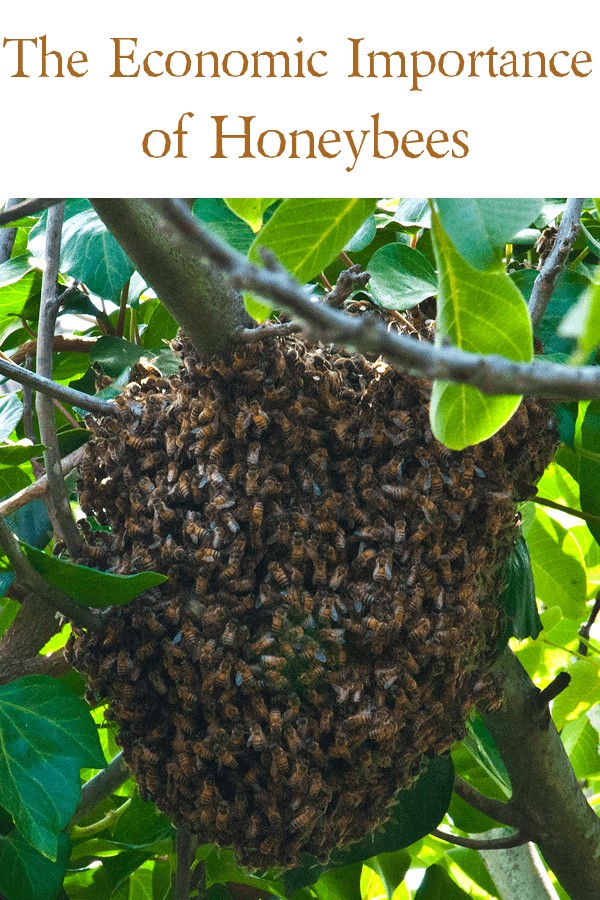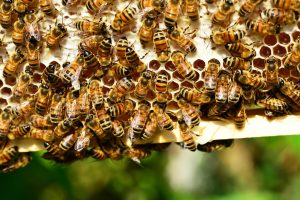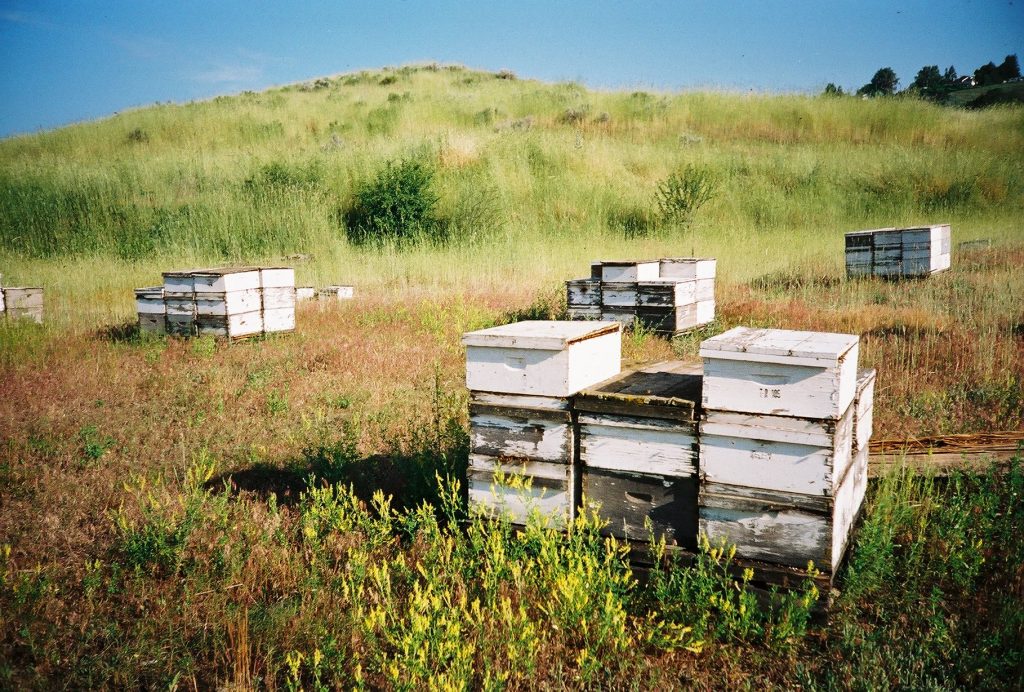The Problems of Assessing Economic Impact
Assessing the economic impact of bees is not as easy as you might think. First you’d have to take into account what food is pollinated by the bees (mostly fruits and vegetables), the products that come directly from honeybees (honey, beeswax, etc.), the people who make their living off bees, and even the sales made at stores that sell to the various products to consumers. Further considerations would include the industries that produce medicines that prevent diseases from killing off the hives. Finally, the impact that honeybees have on a crop is masked by other variables, such as soil nutrients, pests, and microclimates in any given place and year.
Researchers at the University of Florida
Summary of revenue and expenses as reported in Hodges, et. al 2001.
For reference, it costs $125,000 for 3000 hives if a person wants to have a commercial beekeeping operation
But what about the rest of the United States? That was the question that James Chisel’s economic thesis. Chisel
VHB = ∑(VP ) +PF + (VH + VW ) + ∑(PHB ) + ∑(Ext)
where the total sum of the honey bees’ value (VHB ) is equal to the sum of the value of the pollination in crops, the pollination fees (PF ), honey (VH ), wax sales (VW ), the sum of the secondary market (PHB ) and finally the externalities (Ext).
A Hidden Threat
Any time there is a high value product, there will be a market for “dupes” or as demand increases while product decreases, it will be thinned out. During WWI, plaster was mixed with flour to “stretch” the flour supply, and corn syrup, beet sugar, or gluten has been added to honey in the past
Economic adulteration is often caught by testing the products to see if they are up to standards. For example, stable isotopic ratios will be able to detect if corn syrup was added to the honey if it is over 7% of the honey. Fairchild et al surveyed different levels of the honey industry to find out if they tested for such adulteration, how much of a problem it was, and if they were concerned about it.
What they found was interesting. They did test for adulteration in the late 1990s, and 71% of firms that sold honey found that honey was adulterated with corn syrup (no other adulterants were found). Of course, this was reflected in the those surveyed felt that this was an important problem in the industry.
Muddled, But Clear The economics of the honey industry is muddled at best. But it’s also clear that the services and products the honeybees provide are quite valuable. Beyond this many people rely on the honeybee directly or indirectly for their livelihoods. Hopefully we will never have to find out through trial and error just how much we relied on these complex insects.
Bibliography
{21495:TGKJUJEH};{21495:CD5Z6UGP};{21495:CD5Z6UGP};{21495:BQPRTCNF}
apa
default
asc
0
9698
%7B%22status%22%3A%22success%22%2C%22updateneeded%22%3Afalse%2C%22instance%22%3Afalse%2C%22meta%22%3A%7B%22request_last%22%3A450%2C%22request_next%22%3A50%2C%22used_cache%22%3Atrue%7D%2C%22data%22%3A%5B%7B%22key%22%3A%228R9EVEKG%22%2C%22library%22%3A%7B%22id%22%3A21495%7D%2C%22meta%22%3A%7B%22numChildren%22%3A1%7D%2C%22bib%22%3A%22%26lt%3Bdiv%20class%3D%26quot%3Bcsl-bib-body%26quot%3B%20style%3D%26quot%3Bline-height%3A%202%3B%20padding-left%3A%201em%3B%20text-indent%3A-1em%3B%26quot%3B%26gt%3B%5Cn%20%20%26lt%3Bdiv%20class%3D%26quot%3Bcsl-entry%26quot%3B%26gt%3B%26lt%3Bi%26gt%3BIon%20Exchange%20Chromatography%26lt%3B%5C%2Fi%26gt%3B.%20%28n.d.%29.%20Retrieved%20December%2011%2C%202025%2C%20from%20%26lt%3Ba%20class%3D%26%23039%3Bzp-ItemURL%26%23039%3B%20href%3D%26%23039%3Bhttps%3A%5C%2F%5C%2Fwww.shimadzu.com%5C%2Fan%5C%2Fservice-support%5C%2Ftechnical-support%5C%2Fanalysis-basics%5C%2Fbasic%5C%2Fion_exchange_chromatography.html%26%23039%3B%26gt%3Bhttps%3A%5C%2F%5C%2Fwww.shimadzu.com%5C%2Fan%5C%2Fservice-support%5C%2Ftechnical-support%5C%2Fanalysis-basics%5C%2Fbasic%5C%2Fion_exchange_chromatography.html%26lt%3B%5C%2Fa%26gt%3B%26lt%3B%5C%2Fdiv%26gt%3B%5Cn%26lt%3B%5C%2Fdiv%26gt%3B%22%2C%22data%22%3A%7B%22itemType%22%3A%22webpage%22%2C%22title%22%3A%22Ion%20Exchange%20Chromatography%22%2C%22creators%22%3A%5B%5D%2C%22abstractNote%22%3A%22%22%2C%22date%22%3A%22%22%2C%22url%22%3A%22https%3A%5C%2F%5C%2Fwww.shimadzu.com%5C%2Fan%5C%2Fservice-support%5C%2Ftechnical-support%5C%2Fanalysis-basics%5C%2Fbasic%5C%2Fion_exchange_chromatography.html%22%2C%22language%22%3A%22en%22%2C%22collections%22%3A%5B%5D%2C%22dateModified%22%3A%222025-12-11T14%3A27%3A58Z%22%7D%7D%2C%7B%22key%22%3A%22D9T2CF3F%22%2C%22library%22%3A%7B%22id%22%3A21495%7D%2C%22meta%22%3A%7B%22creatorSummary%22%3A%22Curling%22%2C%22parsedDate%22%3A%222025-12-10%22%2C%22numChildren%22%3A1%7D%2C%22bib%22%3A%22%26lt%3Bdiv%20class%3D%26quot%3Bcsl-bib-body%26quot%3B%20style%3D%26quot%3Bline-height%3A%202%3B%20padding-left%3A%201em%3B%20text-indent%3A-1em%3B%26quot%3B%26gt%3B%5Cn%20%20%26lt%3Bdiv%20class%3D%26quot%3Bcsl-entry%26quot%3B%26gt%3BCurling%2C%20J.%20%282025%2C%20December%2010%29.%20%26lt%3Bi%26gt%3BHISTORY%20OF%20CHROMATOGRAPHY%3A%20Process%20Chromatography%3A%20Five%20Decades%20of%20Innovation%20%7C%20BioPharm%20International%26lt%3B%5C%2Fi%26gt%3B.%20%26lt%3Ba%20class%3D%26%23039%3Bzp-ItemURL%26%23039%3B%20href%3D%26%23039%3Bhttps%3A%5C%2F%5C%2Fwww.biopharminternational.com%5C%2Fview%5C%2Fhistory-chromatography-process-chromatography-five-decades-innovation%26%23039%3B%26gt%3Bhttps%3A%5C%2F%5C%2Fwww.biopharminternational.com%5C%2Fview%5C%2Fhistory-chromatography-process-chromatography-five-decades-innovation%26lt%3B%5C%2Fa%26gt%3B%26lt%3B%5C%2Fdiv%26gt%3B%5Cn%26lt%3B%5C%2Fdiv%26gt%3B%22%2C%22data%22%3A%7B%22itemType%22%3A%22webpage%22%2C%22title%22%3A%22HISTORY%20OF%20CHROMATOGRAPHY%3A%20Process%20Chromatography%3A%20Five%20Decades%20of%20Innovation%20%7C%20BioPharm%20International%22%2C%22creators%22%3A%5B%7B%22creatorType%22%3A%22author%22%2C%22firstName%22%3A%22John%22%2C%22lastName%22%3A%22Curling%22%7D%5D%2C%22abstractNote%22%3A%22This%20article%20explores%20the%20development%20of%20process%20chromatography.%20Process%20chromatography%20was%20first%20applied%20to%20the%20removal%20of%20low%20molecular%20weight%20solutes%20from%20whey%20by%20gel%20filtration%20about%2050%20years%20ago.%20An%20analytical%20method%20using%20size%20exclusion%20chromatography%20was%20scaled%20up%20for%20insulin%20production%20in%20the%201970s%2C%20when%20ion%20exchange%20became%20a%20viable%20technology%20for%20the%20same%20application.%20Ion%20exchange%20was%20adopted%20as%20the%20industry%20workhorse%20as%20robust%20resins%20became%20available%20and%20formed%20the%20backbone%20of%20chromatographic%20processing%20of%20blood%20plasma%20fractionation%20in%20alternatives%20to%20and%20extensions%20of%20ethanol%20precipitation.%22%2C%22date%22%3A%222025-12-10T19%3A48%3A34.662Z%22%2C%22url%22%3A%22https%3A%5C%2F%5C%2Fwww.biopharminternational.com%5C%2Fview%5C%2Fhistory-chromatography-process-chromatography-five-decades-innovation%22%2C%22language%22%3A%22en%22%2C%22collections%22%3A%5B%22XAWSHPGP%22%5D%2C%22dateModified%22%3A%222025-12-10T19%3A48%3A41Z%22%7D%7D%2C%7B%22key%22%3A%22GX47WVAD%22%2C%22library%22%3A%7B%22id%22%3A21495%7D%2C%22meta%22%3A%7B%22numChildren%22%3A1%7D%2C%22bib%22%3A%22%26lt%3Bdiv%20class%3D%26quot%3Bcsl-bib-body%26quot%3B%20style%3D%26quot%3Bline-height%3A%202%3B%20padding-left%3A%201em%3B%20text-indent%3A-1em%3B%26quot%3B%26gt%3B%5Cn%20%20%26lt%3Bdiv%20class%3D%26quot%3Bcsl-entry%26quot%3B%26gt%3B%26lt%3Bi%26gt%3BIon%20Exchange%5CnChromatography%3A%20Principles%20and%20Methods%26lt%3B%5C%2Fi%26gt%3B.%20%28n.d.%29.%20GE%20Healthcare.%26lt%3B%5C%2Fdiv%26gt%3B%5Cn%26lt%3B%5C%2Fdiv%26gt%3B%22%2C%22data%22%3A%7B%22itemType%22%3A%22book%22%2C%22title%22%3A%22Ion%20Exchange%5CnChromatography%3A%20Principles%20and%20Methods%22%2C%22creators%22%3A%5B%5D%2C%22abstractNote%22%3A%22%22%2C%22date%22%3A%22%22%2C%22language%22%3A%22%22%2C%22ISBN%22%3A%22%22%2C%22url%22%3A%22%22%2C%22collections%22%3A%5B%22XAWSHPGP%22%5D%2C%22dateModified%22%3A%222025-12-10T19%3A27%3A52Z%22%7D%7D%2C%7B%22key%22%3A%222NQZCYVH%22%2C%22library%22%3A%7B%22id%22%3A21495%7D%2C%22meta%22%3A%7B%22creatorSummary%22%3A%22Jungbauer%20and%20Hahn%22%2C%22parsedDate%22%3A%222009%22%2C%22numChildren%22%3A0%7D%2C%22bib%22%3A%22%26lt%3Bdiv%20class%3D%26quot%3Bcsl-bib-body%26quot%3B%20style%3D%26quot%3Bline-height%3A%202%3B%20padding-left%3A%201em%3B%20text-indent%3A-1em%3B%26quot%3B%26gt%3B%5Cn%20%20%26lt%3Bdiv%20class%3D%26quot%3Bcsl-entry%26quot%3B%26gt%3BJungbauer%2C%20A.%2C%20%26amp%3B%20Hahn%2C%20R.%20%282009%29.%20Chapter%2022%20Ion-Exchange%20Chromatography.%20In%20%26lt%3Bi%26gt%3BMethods%20in%20Enzymology%26lt%3B%5C%2Fi%26gt%3B%20%28Vol.%20463%2C%20pp.%20349%26%23x2013%3B371%29.%20Elsevier.%20https%3A%5C%2F%5C%2Fdoi.org%5C%2F10.1016%5C%2FS0076-6879%2809%2963022-6%26lt%3B%5C%2Fdiv%26gt%3B%5Cn%26lt%3B%5C%2Fdiv%26gt%3B%22%2C%22data%22%3A%7B%22itemType%22%3A%22bookSection%22%2C%22title%22%3A%22Chapter%2022%20Ion-Exchange%20Chromatography%22%2C%22creators%22%3A%5B%7B%22creatorType%22%3A%22author%22%2C%22firstName%22%3A%22Alois%22%2C%22lastName%22%3A%22Jungbauer%22%7D%2C%7B%22creatorType%22%3A%22author%22%2C%22firstName%22%3A%22Rainer%22%2C%22lastName%22%3A%22Hahn%22%7D%5D%2C%22abstractNote%22%3A%22%22%2C%22bookTitle%22%3A%22Methods%20in%20Enzymology%22%2C%22date%22%3A%222009%22%2C%22language%22%3A%22en%22%2C%22ISBN%22%3A%229780123745361%22%2C%22url%22%3A%22https%3A%5C%2F%5C%2Flinkinghub.elsevier.com%5C%2Fretrieve%5C%2Fpii%5C%2FS0076687909630226%22%2C%22collections%22%3A%5B%22XAWSHPGP%22%5D%2C%22dateModified%22%3A%222025-12-10T19%3A16%3A44Z%22%7D%7D%2C%7B%22key%22%3A%22QSRSJUEW%22%2C%22library%22%3A%7B%22id%22%3A21495%7D%2C%22meta%22%3A%7B%22creatorSummary%22%3A%22McSweeny%22%2C%22parsedDate%22%3A%222025-10-17%22%2C%22numChildren%22%3A0%7D%2C%22bib%22%3A%22%26lt%3Bdiv%20class%3D%26quot%3Bcsl-bib-body%26quot%3B%20style%3D%26quot%3Bline-height%3A%202%3B%20padding-left%3A%201em%3B%20text-indent%3A-1em%3B%26quot%3B%26gt%3B%5Cn%20%20%26lt%3Bdiv%20class%3D%26quot%3Bcsl-entry%26quot%3B%26gt%3BMcSweeny%2C%20E.%20%282025%2C%20October%2017%29.%20All%20Charged%20Up%3A%20The%20Basics%20of%20Ion-Exchange%20Chromatography%20%5BScience%20Lab%20Support%5D.%20%26lt%3Bi%26gt%3BBiteSized%20Bio%26lt%3B%5C%2Fi%26gt%3B.%20%26lt%3Ba%20class%3D%26%23039%3Bzp-ItemURL%26%23039%3B%20href%3D%26%23039%3Bhttps%3A%5C%2F%5C%2Fbitesizebio.com%5C%2F31744%5C%2Fbasics-ion-exchange-chromatography%5C%2F%26%23039%3B%26gt%3Bhttps%3A%5C%2F%5C%2Fbitesizebio.com%5C%2F31744%5C%2Fbasics-ion-exchange-chromatography%5C%2F%26lt%3B%5C%2Fa%26gt%3B%26lt%3B%5C%2Fdiv%26gt%3B%5Cn%26lt%3B%5C%2Fdiv%26gt%3B%22%2C%22data%22%3A%7B%22itemType%22%3A%22blogPost%22%2C%22title%22%3A%22All%20Charged%20Up%3A%20The%20Basics%20of%20Ion-Exchange%20Chromatography%22%2C%22creators%22%3A%5B%7B%22creatorType%22%3A%22author%22%2C%22firstName%22%3A%22Elizabeth%22%2C%22lastName%22%3A%22McSweeny%22%7D%5D%2C%22abstractNote%22%3A%22%22%2C%22blogTitle%22%3A%22BiteSized%20Bio%22%2C%22date%22%3A%222025-10-17%22%2C%22url%22%3A%22https%3A%5C%2F%5C%2Fbitesizebio.com%5C%2F31744%5C%2Fbasics-ion-exchange-chromatography%5C%2F%22%2C%22language%22%3A%22%22%2C%22collections%22%3A%5B%22XAWSHPGP%22%5D%2C%22dateModified%22%3A%222025-12-10T19%3A04%3A56Z%22%7D%7D%2C%7B%22key%22%3A%2239EW2GJM%22%2C%22library%22%3A%7B%22id%22%3A21495%7D%2C%22meta%22%3A%7B%22parsedDate%22%3A%222021-10-15%22%2C%22numChildren%22%3A1%7D%2C%22bib%22%3A%22%26lt%3Bdiv%20class%3D%26quot%3Bcsl-bib-body%26quot%3B%20style%3D%26quot%3Bline-height%3A%202%3B%20padding-left%3A%201em%3B%20text-indent%3A-1em%3B%26quot%3B%26gt%3B%5Cn%20%20%26lt%3Bdiv%20class%3D%26quot%3Bcsl-entry%26quot%3B%26gt%3B%26lt%3Bi%26gt%3BIon-Exchange%20Chromatography%3A%20An%20Easy%20Introduction%20to%20the%20Basics%26lt%3B%5C%2Fi%26gt%3B.%20%282021%2C%20October%2015%29.%20%26lt%3Ba%20class%3D%26%23039%3Bzp-ItemURL%26%23039%3B%20href%3D%26%23039%3Bhttps%3A%5C%2F%5C%2Fbitesizebio.com%5C%2F31744%5C%2Fbasics-ion-exchange-chromatography%5C%2F%26%23039%3B%26gt%3Bhttps%3A%5C%2F%5C%2Fbitesizebio.com%5C%2F31744%5C%2Fbasics-ion-exchange-chromatography%5C%2F%26lt%3B%5C%2Fa%26gt%3B%26lt%3B%5C%2Fdiv%26gt%3B%5Cn%26lt%3B%5C%2Fdiv%26gt%3B%22%2C%22data%22%3A%7B%22itemType%22%3A%22webpage%22%2C%22title%22%3A%22Ion-Exchange%20Chromatography%3A%20An%20Easy%20Introduction%20to%20the%20Basics%22%2C%22creators%22%3A%5B%5D%2C%22abstractNote%22%3A%22Ion-exchange%20chromatography%20is%20used%20to%20separate%20and%20purify%20proteins%20based%20on%20net%20charge%20at%20a%20particular%20pH.%20Here%20are%20the%20basics%20about%20this%20technique.%22%2C%22date%22%3A%222021-10-15T09%3A00%3A00%2B01%3A00%22%2C%22url%22%3A%22https%3A%5C%2F%5C%2Fbitesizebio.com%5C%2F31744%5C%2Fbasics-ion-exchange-chromatography%5C%2F%22%2C%22language%22%3A%22en-US%22%2C%22collections%22%3A%5B%5D%2C%22dateModified%22%3A%222025-12-10T19%3A00%3A37Z%22%7D%7D%2C%7B%22key%22%3A%22G4PSMRBP%22%2C%22library%22%3A%7B%22id%22%3A21495%7D%2C%22meta%22%3A%7B%22numChildren%22%3A1%7D%2C%22bib%22%3A%22%26lt%3Bdiv%20class%3D%26quot%3Bcsl-bib-body%26quot%3B%20style%3D%26quot%3Bline-height%3A%202%3B%20padding-left%3A%201em%3B%20text-indent%3A-1em%3B%26quot%3B%26gt%3B%5Cn%20%20%26lt%3Bdiv%20class%3D%26quot%3Bcsl-entry%26quot%3B%26gt%3B%26lt%3Bi%26gt%3BThe%202%20Common%20Types%20of%20Ion%20Exchange%20Chromatography%3A%20Anion%20vs.%20Cation%26lt%3B%5C%2Fi%26gt%3B.%20%28n.d.%29.%20GoldBio.%20Retrieved%20December%2010%2C%202025%2C%20from%20%26lt%3Ba%20class%3D%26%23039%3Bzp-ItemURL%26%23039%3B%20href%3D%26%23039%3Bhttps%3A%5C%2F%5C%2Fwww.goldbio.com%5C%2Fblogs%5C%2Farticles%5C%2F2-common-types-of-ion-exchange-chromatography-anion-vs-cation%26%23039%3B%26gt%3Bhttps%3A%5C%2F%5C%2Fwww.goldbio.com%5C%2Fblogs%5C%2Farticles%5C%2F2-common-types-of-ion-exchange-chromatography-anion-vs-cation%26lt%3B%5C%2Fa%26gt%3B%26lt%3B%5C%2Fdiv%26gt%3B%5Cn%26lt%3B%5C%2Fdiv%26gt%3B%22%2C%22data%22%3A%7B%22itemType%22%3A%22webpage%22%2C%22title%22%3A%22The%202%20Common%20Types%20of%20Ion%20Exchange%20Chromatography%3A%20Anion%20vs.%20Cation%22%2C%22creators%22%3A%5B%5D%2C%22abstractNote%22%3A%22Ion%20exchange%20chromatography%20includes%20a%20suite%20of%20related%20methods%20that%20purify%20proteins%20based%20on%20their%20charge.%5CnThe%20two%20main%20types%20of%20ion%20exchange%20resins%20are%20anion%20and%20cation%2C%20which%20bind%20to%20negatively%20and%20positively%20charged%20molecules%2C%20respectively.%20There%20are%20several%20functional%20groups%20for%20anion%20and%20cation%20exchange%20chromatography%2C%20as%20well%20as%20different%20resolutions.%20%5CnChoosing%20the%20appropriate%20resin%20and%20resolution%20type%20will%20depend%20on%20your%20protein%20of%20interest%20and%20purification%20purpose.%5CnIf%20you%20know%20that%20you%20need%20to%20do%20ion%20exchange%20chromatography%20to%20purify%20your%20protein%2C%20but%20you%5Cu2019re%20not%20sure%20exactly%20what%20type%20of%20ion%20exchange%20you%20should%20do%20%5Cu2013%20you%5Cu2019re%20in%20the%20right%20place%21%20Follow%20along%20as%20we%20discuss%20the%20different%20types%20of%20resins%20used%20for%20ion%20exchange.%5Cn%5CnArticle%20Contents%3A%5Cn%5CnCation%20Exchange%20vs%20Anion%20Exchange%5CnBuffer%20pH%20in%20Ion%20Exchange%20Chromatography%5CnCation%20Exchange%5CnAnion%20Exchange%5CnResolution%5CnRelated%20Products%5CnReferences%5Cn%5Cn%20%5CnCation%20Exchange%20vs%20Anion%20Exchange%5CnThere%20are%20two%20main%20types%20of%20ion%20exchange%3A%20cation%20exchange%20and%20anion%20exchange%20chromatography.%20Let%5Cu2019s%20go%20through%20exactly%20what%20these%20are%2C%20because%20the%20nomenclature%20can%20seem%20counterintuitive%20at%20first.%5CnA%20cation-exchange%20resin%20is%20actually%20negatively%20charged%20and%20binds%20positively-charged%20proteins.%20Conversely%2C%20anion-exchange%20resins%20are%20positively%20charged%20and%20bind%20negatively-charged%20proteins%20%28Figure%201%29.%5Cn%5CnFigure%201.%20Cation%20exchange%20resin%20has%20negatively%20charged%20agarose%20beads%20that%20bind%20positively%20charged%20proteins%20%28left%29.%20Anion%20exchange%20resin%20has%20positively%20charged%20agarose%20beads%20that%20bind%20negatively%20charged%20proteins%20%28right%29.%5CnSo%20the%20first%20thing%20to%20figure%20out%20is%20the%20charge%20of%20the%20protein%20that%20you%20are%20trying%20to%20purify.%5Cn%5Cn%5Cn%5Cn%5Cn%5CnBuffer%20pH%20in%20Ion%20Exchange%20Chromatography%5Cn%5CnA%20protein%5Cu2019s%20charge%2C%20however%2C%20depends%20on%20the%20pH%20of%20the%20buffer%20or%20the%20environment%20that%20it%20is%20in.%20There%20are%20a%20lot%20of%20important%20features%20of%20protein%20purification%20buffers%2C%20and%20we%20discuss%20many%20of%20those%20features%20in%20depth%20here.%20For%20ion%20exchange%20chromatography%20buffers%20in%20particular%2C%20buffer%20pH%20and%20salt%20concentration%20are%20the%20two%20important%20variables%20that%20we%20will%20focus%20on%20in%20this%20article.%5CnTo%20determine%20whether%20your%20protein%20will%20be%20positive%20or%20negative%20at%20a%20given%20pH%2C%20you%20need%20to%20calculate%20the%20isoelectric%20point%2C%20conventionally%20denoted%20as%20%5Cu201cpI%2C%5Cu201d%20of%20a%20protein.%20You%20can%20check%20out%20this%20article%20to%20learn%20how%20to%20estimate%20a%20protein%5Cu2019s%20pI%2C%20and%20how%20to%20use%20that%20information%20to%20determine%20which%20pH%20will%20be%20good%20for%20purifying%20your%20protein%20via%20ion%20exchange.%5Cn%5CnCation%20Exchange%5CnThere%20are%20many%20different%20cation%20exchange%20resins.%20They%20all%20bind%20positively%20charged%20molecules%2C%20but%20they%20use%20slightly%20different%20functional%20groups%20to%20do%20so.%20See%20Table%201%20for%20a%20list%20of%20commonly%20used%20cation-exchange%20resins.%5CnTable%201.%20Cation%20exchange%20functional%20groups.%5Cn%5Cn%5CnOne%20distinction%20you%20will%20see%20in%20Table%201%20is%20strong%20vs.%20weak%20cation%20exchangers.%20Strong%20indicates%20that%20a%20chemical%20moiety%20remains%20charged%2C%20and%20therefore%20useful%20for%20binding%20cations%2C%20across%20a%20broad%20pH%20range%20whereas%20weak%20exchangers%20are%20useful%20over%20a%20more%20limited%20pH%20range.%5CnS%20columns%20are%20strong%20exchangers%20and%20are%20frequently%20used%20as%20a%20standard%20default%20choice%20for%20cation%20exchange.%20However%2C%20if%20you%20are%20working%20off%20of%20an%20existing%20protocol%20that%20calls%20for%20another%20type%20of%20cation%20exchange%20resin%2C%20you%20will%20probably%20want%20to%20try%20that%20type%20of%20resin%20first.%5CnHeparin%20columns%20combine%20features%20of%20ion%20exchange%20%28IEX%29%20columns%20and%20affinity%20columns%20in%20that%20they%20are%20especially%20good%20at%20binding%20positively-charged%20proteins%20that%20bind%20to%20polysaccharides%20or%20nucleic%20acids%20%28Siri%20et%20al%2C%201986%29%2C%20so%20they%20are%20a%20good%20choice%20for%20these%20types%20of%20proteins.%5Cn%5Cn%5CnAnion%20Exchange%5CnSimilarly%2C%20there%20are%20many%20different%20types%20of%20anion%20exchange%20resins%20that%20bind%20negatively%20charged%20molecules%20using%20different%20functional%20groups.%20See%20Table%202%20for%20a%20list%20of%20frequently%20used%20anion%20exchange%20resins.%5Cn%20Table%202.%20Anion%20exchange%20functional%20groups.%20%5Cn%5CnJust%20like%20cation%20exchangers%2C%20strong%20anion%20exchangers%20are%20charged%20over%20a%20broad%20pH%20range%20whereas%20weak%20exchangers%20work%20over%20a%20more%20limited%20pH%20range.%5CnQ%20columns%20are%20strong%20anion%20exchangers%20and%20are%20frequently%20used%20as%20the%20default%20choice%2C%20so%20if%20you%5Cu2019re%20not%20sure%20what%20to%20use%2C%20start%20there.%20However%2C%20if%20you%5Cu2019re%20working%20off%20an%20existing%20protocol%20that%20uses%20a%20different%20anion%20exchange%20resin%2C%20you%20should%20try%20the%20same%20one%20first.%5CnDEAE%20columns%20are%20particularly%20good%20at%20binding%20to%20nucleic%20acids%20and%20are%20frequently%20used%20to%20purify%20DNA%20and%20RNA%20away%20from%20a%20protein%20during%20a%20purification%20%28Ali%20et%20al%2C%202017%29.%5Cn%5CnResolution%5CnWhether%20using%20cation%20or%20anion%20exchange%20resins%2C%20you%20will%20also%20need%20to%20select%20whether%20to%20use%20a%20resin%20that%20is%20high%20or%20moderate%20resolution.%20Resolution%20refers%20to%20the%20ability%20of%20the%20column%20to%20separate%20out%20different%20proteins%20that%20have%20similar%20charge%20properties%20%28Figure%202%29.%5Cn%5Cn%20Figure%202.%20Resolution%20differences%20between%20columns%20determine%20whether%20proteins%20%28different%20purple%20shapes%29%20coelute%20%28left%29%20or%20are%20separated%20%28right%29%20during%20an%20IEX%20purification.%20%5Cn%5CnFor%20ion%20exchange%20chromatography%2C%20resolution%20is%20primarily%20a%20function%20of%20resin%20bead%20size.%20The%20smaller%20the%20beads%2C%20the%20higher%20the%20resolution%20whereas%20the%20larger%20the%20beads%20the%20lower%20the%20resolution%20%28Figure%203%29.%5CnThere%20is%20also%20a%20tradeoff%20between%20resolution%20and%20speed%20in%20that%20high-resolution%20resins%20are%20run%20at%20a%20lower%20flow%20rate%20and%20will%20therefore%20take%20longer.%5CnOften%20the%20decision%20on%20which%20type%20of%20resolution%20is%20optimal%20depends%20on%20the%20exact%20purpose%20you%20are%20using%20ion%20exchange%20for.%20When%20it%20is%20an%20additional%20purification%20step%20between%20affinity%20tag%20and%20size%20exclusion%20purifications%2C%20it%20is%20probably%20fine%20to%20use%20moderate%20resolution%20ion%20exchange%20chromatography%20and%20enjoy%20the%20faster%20purification.%5CnHowever%2C%20there%20are%20some%20special%20uses%20of%20ion%20exchange%20purification%20steps%20where%20it%20may%20be%20worth%20using%20high-resolution%20resin%20to%20purify%20proteins%20with%20posttranslational%20modifications%20or%20of%20different%20oligomeric%20states.%5Cn%5Cn%5CnFigure%203.%20Smaller%20bead%20size%20%28gray%20circles%29%20leads%20to%20increased%20purification%20resolution%20in%20ion%20exchange%20chromatography.%5Cn%5CnSo%20now%20you%20know%20a%20little%20bit%20more%20about%20the%20different%20ion%20exchange%20resin%20types%20and%20how%20to%20pick%20which%20resin%20and%20which%20resolution%20you%20want%20to%20try.%22%2C%22date%22%3A%22%22%2C%22url%22%3A%22https%3A%5C%2F%5C%2Fwww.goldbio.com%5C%2Fblogs%5C%2Farticles%5C%2F2-common-types-of-ion-exchange-chromatography-anion-vs-cation%22%2C%22language%22%3A%22en%22%2C%22collections%22%3A%5B%5D%2C%22dateModified%22%3A%222025-12-10T18%3A53%3A40Z%22%7D%7D%2C%7B%22key%22%3A%22FZ35292N%22%2C%22library%22%3A%7B%22id%22%3A21495%7D%2C%22meta%22%3A%7B%22creatorSummary%22%3A%22Kevin%20Ahern%20and%20Indira%20Rajagopal%22%2C%22parsedDate%22%3A%222019-07-15%22%2C%22numChildren%22%3A1%7D%2C%22bib%22%3A%22%26lt%3Bdiv%20class%3D%26quot%3Bcsl-bib-body%26quot%3B%20style%3D%26quot%3Bline-height%3A%202%3B%20padding-left%3A%201em%3B%20text-indent%3A-1em%3B%26quot%3B%26gt%3B%5Cn%20%20%26lt%3Bdiv%20class%3D%26quot%3Bcsl-entry%26quot%3B%26gt%3BKevin%20Ahern%2C%20%26amp%3B%20Indira%20Rajagopal.%20%282019%2C%20July%2015%29.%20%26lt%3Bi%26gt%3B3.4.3.%20Ion%20Exchange%20Chromatography%26lt%3B%5C%2Fi%26gt%3B.%20Chemistry%20LibreTexts.%20%26lt%3Ba%20class%3D%26%23039%3Bzp-ItemURL%26%23039%3B%20href%3D%26%23039%3Bhttps%3A%5C%2F%5C%2Fchem.libretexts.org%5C%2FCourses%5C%2FUniversity_of_Arkansas_Little_Rock%5C%2FCHEM_4320_5320%253A_Biochemistry_1%5C%2F03%253A_Methods_of_Protein_Purification_and_Characterization%5C%2F3.4%253A_Chromatography%5C%2F3.4.3._Ion_Exchange_Chromatography%26%23039%3B%26gt%3Bhttps%3A%5C%2F%5C%2Fchem.libretexts.org%5C%2FCourses%5C%2FUniversity_of_Arkansas_Little_Rock%5C%2FCHEM_4320_5320%253A_Biochemistry_1%5C%2F03%253A_Methods_of_Protein_Purification_and_Characterization%5C%2F3.4%253A_Chromatography%5C%2F3.4.3._Ion_Exchange_Chromatography%26lt%3B%5C%2Fa%26gt%3B%26lt%3B%5C%2Fdiv%26gt%3B%5Cn%26lt%3B%5C%2Fdiv%26gt%3B%22%2C%22data%22%3A%7B%22itemType%22%3A%22webpage%22%2C%22title%22%3A%223.4.3.%20Ion%20Exchange%20Chromatography%22%2C%22creators%22%3A%5B%7B%22creatorType%22%3A%22author%22%2C%22name%22%3A%22Kevin%20Ahern%22%7D%2C%7B%22creatorType%22%3A%22author%22%2C%22name%22%3A%22Indira%20Rajagopal%22%7D%5D%2C%22abstractNote%22%3A%22Proteins%20can%20be%20separated%20on%20the%20basis%20of%20their%20net%20charge%20by%20ion-exchange%20chromatography.%20If%20a%20protein%20has%20a%20net%20positive%20charge%20at%20pH%207%2C%20it%20will%20bind%20to%20a%20column%20of%20beads%20containing%20carboxylate%20%5Cu2026%22%2C%22date%22%3A%222019-07-15T05%3A50%3A33Z%22%2C%22url%22%3A%22https%3A%5C%2F%5C%2Fchem.libretexts.org%5C%2FCourses%5C%2FUniversity_of_Arkansas_Little_Rock%5C%2FCHEM_4320_5320%253A_Biochemistry_1%5C%2F03%253A_Methods_of_Protein_Purification_and_Characterization%5C%2F3.4%253A_Chromatography%5C%2F3.4.3._Ion_Exchange_Chromatography%22%2C%22language%22%3A%22en%22%2C%22collections%22%3A%5B%22XAWSHPGP%22%5D%2C%22dateModified%22%3A%222025-12-10T18%3A48%3A32Z%22%7D%7D%2C%7B%22key%22%3A%223AQDI8AH%22%2C%22library%22%3A%7B%22id%22%3A21495%7D%2C%22meta%22%3A%7B%22creatorSummary%22%3A%22Small%22%2C%22parsedDate%22%3A%222025-12-10%22%2C%22numChildren%22%3A1%7D%2C%22bib%22%3A%22%26lt%3Bdiv%20class%3D%26quot%3Bcsl-bib-body%26quot%3B%20style%3D%26quot%3Bline-height%3A%202%3B%20padding-left%3A%201em%3B%20text-indent%3A-1em%3B%26quot%3B%26gt%3B%5Cn%20%20%26lt%3Bdiv%20class%3D%26quot%3Bcsl-entry%26quot%3B%26gt%3BSmall%2C%20H.%20%282025%2C%20December%2010%29.%20%26lt%3Bi%26gt%3BLandmarks%20in%20the%20Evolution%20of%20Ion%20Chromatography%20%7C%20LCGC%20International%26lt%3B%5C%2Fi%26gt%3B.%20%26lt%3Ba%20class%3D%26%23039%3Bzp-ItemURL%26%23039%3B%20href%3D%26%23039%3Bhttps%3A%5C%2F%5C%2Fwww.chromatographyonline.com%5C%2Fview%5C%2Flandmarks-evolution-ion-chromatography%26%23039%3B%26gt%3Bhttps%3A%5C%2F%5C%2Fwww.chromatographyonline.com%5C%2Fview%5C%2Flandmarks-evolution-ion-chromatography%26lt%3B%5C%2Fa%26gt%3B%26lt%3B%5C%2Fdiv%26gt%3B%5Cn%26lt%3B%5C%2Fdiv%26gt%3B%22%2C%22data%22%3A%7B%22itemType%22%3A%22webpage%22%2C%22title%22%3A%22Landmarks%20in%20the%20Evolution%20of%20Ion%20Chromatography%20%7C%20LCGC%20International%22%2C%22creators%22%3A%5B%7B%22creatorType%22%3A%22author%22%2C%22firstName%22%3A%22Hamish%22%2C%22lastName%22%3A%22Small%22%7D%5D%2C%22abstractNote%22%3A%22From%20the%20invention%20of%20eluent%20suppression%20to%20today%26%23039%3Bs%20%26quot%3Bjust%20add%20water%26quot%3B%20concept%2C%20pivotal%20developments%20over%20the%20last%2040%20years%20are%20chronologically%20highlighted%20from%20a%20chemical%20and%20instrumental%20viewpoint.%22%2C%22date%22%3A%222025-12-10T18%3A40%3A03.203Z%22%2C%22url%22%3A%22https%3A%5C%2F%5C%2Fwww.chromatographyonline.com%5C%2Fview%5C%2Flandmarks-evolution-ion-chromatography%22%2C%22language%22%3A%22en%22%2C%22collections%22%3A%5B%5D%2C%22dateModified%22%3A%222025-12-10T18%3A41%3A10Z%22%7D%7D%2C%7B%22key%22%3A%22HYKKEQLS%22%2C%22library%22%3A%7B%22id%22%3A21495%7D%2C%22meta%22%3A%7B%22numChildren%22%3A1%7D%2C%22bib%22%3A%22%26lt%3Bdiv%20class%3D%26quot%3Bcsl-bib-body%26quot%3B%20style%3D%26quot%3Bline-height%3A%202%3B%20padding-left%3A%201em%3B%20text-indent%3A-1em%3B%26quot%3B%26gt%3B%5Cn%20%20%26lt%3Bdiv%20class%3D%26quot%3Bcsl-entry%26quot%3B%26gt%3B%26lt%3Bi%26gt%3BEvolution%20and%20Impact%20of%20Ion-Exchange%20Chromatography%26lt%3B%5C%2Fi%26gt%3B.%20%28n.d.%29.%20Chrom%20Tech%2C%20Inc.%20Retrieved%20December%2010%2C%202025%2C%20from%20%26lt%3Ba%20class%3D%26%23039%3Bzp-ItemURL%26%23039%3B%20href%3D%26%23039%3Bhttps%3A%5C%2F%5C%2Fchromtech.com%5C%2Fblog%5C%2Fevolution-and-impact-of-ion-exchange-chromatography%5C%2F%26%23039%3B%26gt%3Bhttps%3A%5C%2F%5C%2Fchromtech.com%5C%2Fblog%5C%2Fevolution-and-impact-of-ion-exchange-chromatography%5C%2F%26lt%3B%5C%2Fa%26gt%3B%26lt%3B%5C%2Fdiv%26gt%3B%5Cn%26lt%3B%5C%2Fdiv%26gt%3B%22%2C%22data%22%3A%7B%22itemType%22%3A%22webpage%22%2C%22title%22%3A%22Evolution%20and%20Impact%20of%20Ion-Exchange%20Chromatography%22%2C%22creators%22%3A%5B%5D%2C%22abstractNote%22%3A%22Discover%20the%20evolution%20and%20impact%20of%20ion-exchange%20chromatography.%20Learn%20about%20its%20principles%2C%20technical%20aspects%2C%20applications%2C%20and%20innovations%20in%20the%20field.%22%2C%22date%22%3A%22%22%2C%22url%22%3A%22https%3A%5C%2F%5C%2Fchromtech.com%5C%2Fblog%5C%2Fevolution-and-impact-of-ion-exchange-chromatography%5C%2F%22%2C%22language%22%3A%22en%22%2C%22collections%22%3A%5B%5D%2C%22dateModified%22%3A%222025-12-10T18%3A38%3A04Z%22%7D%7D%2C%7B%22key%22%3A%22V4FSXLRP%22%2C%22library%22%3A%7B%22id%22%3A21495%7D%2C%22meta%22%3A%7B%22creatorSummary%22%3A%22Buie%22%2C%22numChildren%22%3A1%7D%2C%22bib%22%3A%22%26lt%3Bdiv%20class%3D%26quot%3Bcsl-bib-body%26quot%3B%20style%3D%26quot%3Bline-height%3A%202%3B%20padding-left%3A%201em%3B%20text-indent%3A-1em%3B%26quot%3B%26gt%3B%5Cn%20%20%26lt%3Bdiv%20class%3D%26quot%3Bcsl-entry%26quot%3B%26gt%3BBuie%2C%20J.%20%28n.d.%29.%20%26lt%3Bi%26gt%3BEvolution%20of%20Chromatography%20Columns%26lt%3B%5C%2Fi%26gt%3B.%20Lab%20Manager.%20Retrieved%20December%2010%2C%202025%2C%20from%20%26lt%3Ba%20class%3D%26%23039%3Bzp-ItemURL%26%23039%3B%20href%3D%26%23039%3Bhttps%3A%5C%2F%5C%2Fwww.labmanager.com%5C%2Fevolution-of-chromatography-columns-18674%26%23039%3B%26gt%3Bhttps%3A%5C%2F%5C%2Fwww.labmanager.com%5C%2Fevolution-of-chromatography-columns-18674%26lt%3B%5C%2Fa%26gt%3B%26lt%3B%5C%2Fdiv%26gt%3B%5Cn%26lt%3B%5C%2Fdiv%26gt%3B%22%2C%22data%22%3A%7B%22itemType%22%3A%22webpage%22%2C%22title%22%3A%22Evolution%20of%20Chromatography%20Columns%22%2C%22creators%22%3A%5B%7B%22creatorType%22%3A%22author%22%2C%22firstName%22%3A%22John%22%2C%22lastName%22%3A%22Buie%22%7D%5D%2C%22abstractNote%22%3A%22The%20history%20of%20chromatography%20dates%20back%20to%20the%20mid-19th%20century%22%2C%22date%22%3A%22%22%2C%22url%22%3A%22https%3A%5C%2F%5C%2Fwww.labmanager.com%5C%2Fevolution-of-chromatography-columns-18674%22%2C%22language%22%3A%22en%22%2C%22collections%22%3A%5B%5D%2C%22dateModified%22%3A%222025-12-10T18%3A35%3A38Z%22%7D%7D%2C%7B%22key%22%3A%22U8PXPKWZ%22%2C%22library%22%3A%7B%22id%22%3A21495%7D%2C%22meta%22%3A%7B%22creatorSummary%22%3A%22Today%22%2C%22numChildren%22%3A1%7D%2C%22bib%22%3A%22%26lt%3Bdiv%20class%3D%26quot%3Bcsl-bib-body%26quot%3B%20style%3D%26quot%3Bline-height%3A%202%3B%20padding-left%3A%201em%3B%20text-indent%3A-1em%3B%26quot%3B%26gt%3B%5Cn%20%20%26lt%3Bdiv%20class%3D%26quot%3Bcsl-entry%26quot%3B%26gt%3BToday%2C%20C.%20%28n.d.%29.%20%26lt%3Bi%26gt%3BDiscovering%20Ion%20Exchange%20Chromatography%26%23x2019%3Bs%20Fascinating%20History%26lt%3B%5C%2Fi%26gt%3B.%20Chromatography%20Today.%20Retrieved%20December%2010%2C%202025%2C%20from%20%26lt%3Ba%20class%3D%26%23039%3Bzp-ItemURL%26%23039%3B%20href%3D%26%23039%3Bhttps%3A%5C%2F%5C%2Fwww.chromatographytoday.com%5C%2Fnews%5C%2Fpreparative%5C%2F33%5C%2Fbreaking-news%5C%2Fdiscovering-ion-exchange-chromatographyrsquos-fascinating-history%5C%2F34442%26%23039%3B%26gt%3Bhttps%3A%5C%2F%5C%2Fwww.chromatographytoday.com%5C%2Fnews%5C%2Fpreparative%5C%2F33%5C%2Fbreaking-news%5C%2Fdiscovering-ion-exchange-chromatographyrsquos-fascinating-history%5C%2F34442%26lt%3B%5C%2Fa%26gt%3B%26lt%3B%5C%2Fdiv%26gt%3B%5Cn%26lt%3B%5C%2Fdiv%26gt%3B%22%2C%22data%22%3A%7B%22itemType%22%3A%22webpage%22%2C%22title%22%3A%22Discovering%20Ion%20Exchange%20Chromatography%5Cu2019s%20Fascinating%20History%22%2C%22creators%22%3A%5B%7B%22creatorType%22%3A%22author%22%2C%22firstName%22%3A%22Chromatography%22%2C%22lastName%22%3A%22Today%22%7D%5D%2C%22abstractNote%22%3A%22Ion%20exchange%20chromatography%20%28IEX%29%20works%20by%20separating%20out%20ions%20and%20polar%20molecules%20by%20using%20the%20amount%20of%20charge%20that%20each%20individual%20component%20holds.%20It%20can%20be%20applied%20to%20pretty%20much%20any%20charged%20m...%22%2C%22date%22%3A%22%22%2C%22url%22%3A%22https%3A%5C%2F%5C%2Fwww.chromatographytoday.com%5C%2Fnews%5C%2Fpreparative%5C%2F33%5C%2Fbreaking-news%5C%2Fdiscovering-ion-exchange-chromatographyrsquos-fascinating-history%5C%2F34442%22%2C%22language%22%3A%22en%22%2C%22collections%22%3A%5B%5D%2C%22dateModified%22%3A%222025-12-10T18%3A28%3A10Z%22%7D%7D%2C%7B%22key%22%3A%22ZGFFSD5I%22%2C%22library%22%3A%7B%22id%22%3A21495%7D%2C%22meta%22%3A%7B%22numChildren%22%3A1%7D%2C%22bib%22%3A%22%26lt%3Bdiv%20class%3D%26quot%3Bcsl-bib-body%26quot%3B%20style%3D%26quot%3Bline-height%3A%202%3B%20padding-left%3A%201em%3B%20text-indent%3A-1em%3B%26quot%3B%26gt%3B%5Cn%20%20%26lt%3Bdiv%20class%3D%26quot%3Bcsl-entry%26quot%3B%26gt%3B%26lt%3Bi%26gt%3BIon%20Exchange%20Chromatography%20-%20an%20overview%20%7C%20ScienceDirect%20Topics%26lt%3B%5C%2Fi%26gt%3B.%20%28n.d.%29.%20Retrieved%20December%2010%2C%202025%2C%20from%20%26lt%3Ba%20class%3D%26%23039%3Bzp-ItemURL%26%23039%3B%20href%3D%26%23039%3Bhttps%3A%5C%2F%5C%2Fwww.sciencedirect.com%5C%2Ftopics%5C%2Fbiochemistry-genetics-and-molecular-biology%5C%2Fion-exchange-chromatography%26%23039%3B%26gt%3Bhttps%3A%5C%2F%5C%2Fwww.sciencedirect.com%5C%2Ftopics%5C%2Fbiochemistry-genetics-and-molecular-biology%5C%2Fion-exchange-chromatography%26lt%3B%5C%2Fa%26gt%3B%26lt%3B%5C%2Fdiv%26gt%3B%5Cn%26lt%3B%5C%2Fdiv%26gt%3B%22%2C%22data%22%3A%7B%22itemType%22%3A%22webpage%22%2C%22title%22%3A%22Ion%20Exchange%20Chromatography%20-%20an%20overview%20%7C%20ScienceDirect%20Topics%22%2C%22creators%22%3A%5B%5D%2C%22abstractNote%22%3A%22%22%2C%22date%22%3A%22%22%2C%22url%22%3A%22https%3A%5C%2F%5C%2Fwww.sciencedirect.com%5C%2Ftopics%5C%2Fbiochemistry-genetics-and-molecular-biology%5C%2Fion-exchange-chromatography%22%2C%22language%22%3A%22%22%2C%22collections%22%3A%5B%5D%2C%22dateModified%22%3A%222025-12-10T18%3A26%3A10Z%22%7D%7D%2C%7B%22key%22%3A%226574LUS2%22%2C%22library%22%3A%7B%22id%22%3A21495%7D%2C%22meta%22%3A%7B%22creatorSummary%22%3A%22Cummins%20et%20al.%22%2C%22parsedDate%22%3A%222017%22%2C%22numChildren%22%3A0%7D%2C%22bib%22%3A%22%26lt%3Bdiv%20class%3D%26quot%3Bcsl-bib-body%26quot%3B%20style%3D%26quot%3Bline-height%3A%202%3B%20padding-left%3A%201em%3B%20text-indent%3A-1em%3B%26quot%3B%26gt%3B%5Cn%20%20%26lt%3Bdiv%20class%3D%26quot%3Bcsl-entry%26quot%3B%26gt%3BCummins%2C%20P.%20M.%2C%20Rochfort%2C%20K.%20D.%2C%20%26amp%3B%20O%26%23x2019%3BConnor%2C%20B.%20F.%20%282017%29.%20Ion-Exchange%20Chromatography%3A%20Basic%20Principles%20and%20Application.%20In%20D.%20Walls%20%26amp%3B%20S.%20T.%20Loughran%20%28Eds.%29%2C%20%26lt%3Bi%26gt%3BProtein%20Chromatography%26lt%3B%5C%2Fi%26gt%3B%20%28Vol.%201485%2C%20pp.%20209%26%23x2013%3B223%29.%20Springer%20New%20York.%20https%3A%5C%2F%5C%2Fdoi.org%5C%2F10.1007%5C%2F978-1-4939-6412-3_11%26lt%3B%5C%2Fdiv%26gt%3B%5Cn%26lt%3B%5C%2Fdiv%26gt%3B%22%2C%22data%22%3A%7B%22itemType%22%3A%22bookSection%22%2C%22title%22%3A%22Ion-Exchange%20Chromatography%3A%20Basic%20Principles%20and%20Application%22%2C%22creators%22%3A%5B%7B%22creatorType%22%3A%22editor%22%2C%22firstName%22%3A%22Dermot%22%2C%22lastName%22%3A%22Walls%22%7D%2C%7B%22creatorType%22%3A%22editor%22%2C%22firstName%22%3A%22Sin%5Cu00e9ad%20T.%22%2C%22lastName%22%3A%22Loughran%22%7D%2C%7B%22creatorType%22%3A%22author%22%2C%22firstName%22%3A%22Philip%20M.%22%2C%22lastName%22%3A%22Cummins%22%7D%2C%7B%22creatorType%22%3A%22author%22%2C%22firstName%22%3A%22Keith%20D.%22%2C%22lastName%22%3A%22Rochfort%22%7D%2C%7B%22creatorType%22%3A%22author%22%2C%22firstName%22%3A%22Brendan%20F.%22%2C%22lastName%22%3A%22O%5Cu2019Connor%22%7D%5D%2C%22abstractNote%22%3A%22%22%2C%22bookTitle%22%3A%22Protein%20Chromatography%22%2C%22date%22%3A%222017%22%2C%22language%22%3A%22%22%2C%22ISBN%22%3A%229781493964109%209781493964123%22%2C%22url%22%3A%22http%3A%5C%2F%5C%2Flink.springer.com%5C%2F10.1007%5C%2F978-1-4939-6412-3_11%22%2C%22collections%22%3A%5B%22XAWSHPGP%22%5D%2C%22dateModified%22%3A%222025-12-10T18%3A25%3A14Z%22%7D%7D%2C%7B%22key%22%3A%22XH3A8E6B%22%2C%22library%22%3A%7B%22id%22%3A21495%7D%2C%22meta%22%3A%7B%22numChildren%22%3A1%7D%2C%22bib%22%3A%22%26lt%3Bdiv%20class%3D%26quot%3Bcsl-bib-body%26quot%3B%20style%3D%26quot%3Bline-height%3A%202%3B%20padding-left%3A%201em%3B%20text-indent%3A-1em%3B%26quot%3B%26gt%3B%5Cn%20%20%26lt%3Bdiv%20class%3D%26quot%3Bcsl-entry%26quot%3B%26gt%3B%26lt%3Bi%26gt%3B28.4%3A%20Partition%20Chromatography%20-%20Chemistry%20LibreTexts%26lt%3B%5C%2Fi%26gt%3B.%20%28n.d.%29.%20Retrieved%20December%206%2C%202025%2C%20from%20%26lt%3Ba%20class%3D%26%23039%3Bzp-ItemURL%26%23039%3B%20href%3D%26%23039%3Bhttps%3A%5C%2F%5C%2Fchem.libretexts.org%5C%2FBookshelves%5C%2FAnalytical_Chemistry%5C%2FInstrumental_Analysis_%28LibreTexts%29%5C%2F28%3A_High-Performance_Liquid_Chromatography%5C%2F28.04%3A_Partition_Chromatography%26%23039%3B%26gt%3Bhttps%3A%5C%2F%5C%2Fchem.libretexts.org%5C%2FBookshelves%5C%2FAnalytical_Chemistry%5C%2FInstrumental_Analysis_%28LibreTexts%29%5C%2F28%3A_High-Performance_Liquid_Chromatography%5C%2F28.04%3A_Partition_Chromatography%26lt%3B%5C%2Fa%26gt%3B%26lt%3B%5C%2Fdiv%26gt%3B%5Cn%26lt%3B%5C%2Fdiv%26gt%3B%22%2C%22data%22%3A%7B%22itemType%22%3A%22webpage%22%2C%22title%22%3A%2228.4%3A%20Partition%20Chromatography%20-%20Chemistry%20LibreTexts%22%2C%22creators%22%3A%5B%5D%2C%22abstractNote%22%3A%22%22%2C%22date%22%3A%22%22%2C%22url%22%3A%22https%3A%5C%2F%5C%2Fchem.libretexts.org%5C%2FBookshelves%5C%2FAnalytical_Chemistry%5C%2FInstrumental_Analysis_%28LibreTexts%29%5C%2F28%3A_High-Performance_Liquid_Chromatography%5C%2F28.04%3A_Partition_Chromatography%22%2C%22language%22%3A%22%22%2C%22collections%22%3A%5B%22XAWSHPGP%22%5D%2C%22dateModified%22%3A%222025-12-06T21%3A02%3A23Z%22%7D%7D%2C%7B%22key%22%3A%22AWQU363B%22%2C%22library%22%3A%7B%22id%22%3A21495%7D%2C%22meta%22%3A%7B%22parsedDate%22%3A%222025-12-06%22%2C%22numChildren%22%3A1%7D%2C%22bib%22%3A%22%26lt%3Bdiv%20class%3D%26quot%3Bcsl-bib-body%26quot%3B%20style%3D%26quot%3Bline-height%3A%202%3B%20padding-left%3A%201em%3B%20text-indent%3A-1em%3B%26quot%3B%26gt%3B%5Cn%20%20%26lt%3Bdiv%20class%3D%26quot%3Bcsl-entry%26quot%3B%26gt%3BChromatography.%20%282025%29.%20In%20%26lt%3Bi%26gt%3BWikipedia%26lt%3B%5C%2Fi%26gt%3B.%20%26lt%3Ba%20class%3D%26%23039%3Bzp-ItemURL%26%23039%3B%20href%3D%26%23039%3Bhttps%3A%5C%2F%5C%2Fen.wikipedia.org%5C%2Fw%5C%2Findex.php%3Ftitle%3DChromatography%26amp%3Boldid%3D1326037608%26%23039%3B%26gt%3Bhttps%3A%5C%2F%5C%2Fen.wikipedia.org%5C%2Fw%5C%2Findex.php%3Ftitle%3DChromatography%26amp%3Boldid%3D1326037608%26lt%3B%5C%2Fa%26gt%3B%26lt%3B%5C%2Fdiv%26gt%3B%5Cn%26lt%3B%5C%2Fdiv%26gt%3B%22%2C%22data%22%3A%7B%22itemType%22%3A%22encyclopediaArticle%22%2C%22title%22%3A%22Chromatography%22%2C%22creators%22%3A%5B%5D%2C%22abstractNote%22%3A%22In%20chemical%20analysis%2C%20chromatography%20is%20a%20laboratory%20technique%20for%20the%20separation%20of%20a%20mixture%20into%20its%20components.%20The%20mixture%20is%20dissolved%20in%20a%20fluid%20solvent%20%28gas%20or%20liquid%29%20called%20the%20mobile%20phase%2C%20which%20carries%20it%20through%20a%20system%20%28a%20column%2C%20a%20capillary%20tube%2C%20a%20plate%2C%20or%20a%20sheet%29%20on%20which%20a%20material%20called%20the%20stationary%20phase%20is%20fixed.%20As%20the%20different%20constituents%20of%20the%20mixture%20tend%20to%20have%20different%20affinities%20for%20the%20stationary%20phase%20and%20are%20retained%20for%20different%20lengths%20of%20time%20depending%20on%20their%20interactions%20with%20its%20surface%20sites%2C%20the%20constituents%20travel%20at%20different%20apparent%20velocities%20in%20the%20mobile%20fluid%2C%20causing%20them%20to%20separate.%20The%20separation%20is%20based%20on%20the%20differential%20partitioning%20between%20the%20mobile%20and%20the%20stationary%20phases.%20Subtle%20differences%20in%20a%20compound%26%23039%3Bs%20partition%20coefficient%20result%20in%20differential%20retention%20on%20the%20stationary%20phase%20and%20thus%20affect%20the%20separation.%5CnChromatography%20may%20be%20preparative%20or%20analytical.%20The%20purpose%20of%20preparative%20chromatography%20is%20to%20separate%20the%20components%20of%20a%20mixture%20for%20later%20use%2C%20and%20is%20thus%20a%20form%20of%20purification.%20This%20process%20is%20associated%20with%20higher%20costs%20due%20to%20its%20mode%20of%20production.%20Analytical%20chromatography%20is%20done%20normally%20with%20smaller%20amounts%20of%20material%20and%20is%20for%20establishing%20the%20presence%20or%20measuring%20the%20relative%20proportions%20of%20analytes%20in%20a%20mixture.%20The%20two%20types%20are%20not%20mutually%20exclusive.%22%2C%22encyclopediaTitle%22%3A%22Wikipedia%22%2C%22date%22%3A%222025-12-06T18%3A55%3A13Z%22%2C%22ISBN%22%3A%22%22%2C%22url%22%3A%22https%3A%5C%2F%5C%2Fen.wikipedia.org%5C%2Fw%5C%2Findex.php%3Ftitle%3DChromatography%26oldid%3D1326037608%22%2C%22language%22%3A%22en%22%2C%22collections%22%3A%5B%5D%2C%22dateModified%22%3A%222025-12-06T20%3A59%3A00Z%22%7D%7D%2C%7B%22key%22%3A%22SXQFZB8P%22%2C%22library%22%3A%7B%22id%22%3A21495%7D%2C%22meta%22%3A%7B%22numChildren%22%3A1%7D%2C%22bib%22%3A%22%26lt%3Bdiv%20class%3D%26quot%3Bcsl-bib-body%26quot%3B%20style%3D%26quot%3Bline-height%3A%202%3B%20padding-left%3A%201em%3B%20text-indent%3A-1em%3B%26quot%3B%26gt%3B%5Cn%20%20%26lt%3Bdiv%20class%3D%26quot%3Bcsl-entry%26quot%3B%26gt%3B%26lt%3Bi%26gt%3BUnderstanding%20Partition%20Chromatography%3A%20Key%20Principles%20and%20Uses%26lt%3B%5C%2Fi%26gt%3B.%20%28n.d.%29.%20Chrom%20Tech%2C%20Inc.%20Retrieved%20December%206%2C%202025%2C%20from%20%26lt%3Ba%20class%3D%26%23039%3Bzp-ItemURL%26%23039%3B%20href%3D%26%23039%3Bhttps%3A%5C%2F%5C%2Fchromtech.com%5C%2Fblog%5C%2Funderstanding-partition-chromatography-key-principles-and-uses%5C%2F%26%23039%3B%26gt%3Bhttps%3A%5C%2F%5C%2Fchromtech.com%5C%2Fblog%5C%2Funderstanding-partition-chromatography-key-principles-and-uses%5C%2F%26lt%3B%5C%2Fa%26gt%3B%26lt%3B%5C%2Fdiv%26gt%3B%5Cn%26lt%3B%5C%2Fdiv%26gt%3B%22%2C%22data%22%3A%7B%22itemType%22%3A%22webpage%22%2C%22title%22%3A%22Understanding%20Partition%20Chromatography%3A%20Key%20Principles%20and%20Uses%22%2C%22creators%22%3A%5B%5D%2C%22abstractNote%22%3A%22Learn%20the%20key%20principles%20and%20uses%20of%20partition%20chromatography.%20Explore%20its%20fundamentals%2C%20techniques%2C%20and%20applications%20across%20industries.%22%2C%22date%22%3A%22%22%2C%22url%22%3A%22https%3A%5C%2F%5C%2Fchromtech.com%5C%2Fblog%5C%2Funderstanding-partition-chromatography-key-principles-and-uses%5C%2F%22%2C%22language%22%3A%22en%22%2C%22collections%22%3A%5B%5D%2C%22dateModified%22%3A%222025-12-06T20%3A58%3A49Z%22%7D%7D%2C%7B%22key%22%3A%22GMLYGF7U%22%2C%22library%22%3A%7B%22id%22%3A21495%7D%2C%22meta%22%3A%7B%22creatorSummary%22%3A%22Today%22%2C%22numChildren%22%3A1%7D%2C%22bib%22%3A%22%26lt%3Bdiv%20class%3D%26quot%3Bcsl-bib-body%26quot%3B%20style%3D%26quot%3Bline-height%3A%202%3B%20padding-left%3A%201em%3B%20text-indent%3A-1em%3B%26quot%3B%26gt%3B%5Cn%20%20%26lt%3Bdiv%20class%3D%26quot%3Bcsl-entry%26quot%3B%26gt%3BToday%2C%20C.%20%28n.d.%29.%20%26lt%3Bi%26gt%3BWhy%20is%20Chromatography%20Called%20Chromatography%3F%26lt%3B%5C%2Fi%26gt%3B%20Chromatography%20Today.%20Retrieved%20December%206%2C%202025%2C%20from%20%26lt%3Ba%20class%3D%26%23039%3Bzp-ItemURL%26%23039%3B%20href%3D%26%23039%3Bhttps%3A%5C%2F%5C%2Fwww.chromatographytoday.com%5C%2Fnews%5C%2Fgc-mdgc%5C%2F32%5C%2Fbreaking-news%5C%2Fwhy-is-chromatography-called-chromatography%5C%2F31178%26%23039%3B%26gt%3Bhttps%3A%5C%2F%5C%2Fwww.chromatographytoday.com%5C%2Fnews%5C%2Fgc-mdgc%5C%2F32%5C%2Fbreaking-news%5C%2Fwhy-is-chromatography-called-chromatography%5C%2F31178%26lt%3B%5C%2Fa%26gt%3B%26lt%3B%5C%2Fdiv%26gt%3B%5Cn%26lt%3B%5C%2Fdiv%26gt%3B%22%2C%22data%22%3A%7B%22itemType%22%3A%22webpage%22%2C%22title%22%3A%22Why%20is%20Chromatography%20Called%20Chromatography%3F%22%2C%22creators%22%3A%5B%7B%22creatorType%22%3A%22author%22%2C%22firstName%22%3A%22Chromatography%22%2C%22lastName%22%3A%22Today%22%7D%5D%2C%22abstractNote%22%3A%22Chromatography%20is%20the%20practice%20of%20separating%20out%20a%20compound%20into%20its%20various%20components%20to%20quantify%20and%20identify%20them.%20This%20is%20achieved%20by%20converting%20a%20solid%20or%20liquid%20into%20a%20gas%2C%20and%20measuring%20the...%22%2C%22date%22%3A%22%22%2C%22url%22%3A%22https%3A%5C%2F%5C%2Fwww.chromatographytoday.com%5C%2Fnews%5C%2Fgc-mdgc%5C%2F32%5C%2Fbreaking-news%5C%2Fwhy-is-chromatography-called-chromatography%5C%2F31178%22%2C%22language%22%3A%22en%22%2C%22collections%22%3A%5B%5D%2C%22dateModified%22%3A%222025-12-06T20%3A48%3A18Z%22%7D%7D%2C%7B%22key%22%3A%22W34NE55F%22%2C%22library%22%3A%7B%22id%22%3A21495%7D%2C%22meta%22%3A%7B%22creatorSummary%22%3A%22Unfiltered%22%2C%22parsedDate%22%3A%222020-09-29%22%2C%22numChildren%22%3A1%7D%2C%22bib%22%3A%22%26lt%3Bdiv%20class%3D%26quot%3Bcsl-bib-body%26quot%3B%20style%3D%26quot%3Bline-height%3A%202%3B%20padding-left%3A%201em%3B%20text-indent%3A-1em%3B%26quot%3B%26gt%3B%5Cn%20%20%26lt%3Bdiv%20class%3D%26quot%3Bcsl-entry%26quot%3B%26gt%3BUnfiltered%2C%20S.%20%282020%2C%20September%2029%29.%20The%20People%20Who%20Shaped%20Chromatography%20%26%23x2013%3B%20Mikhail%20Tsvet.%20%26lt%3Bi%26gt%3BSCIENCE%20UNFILTERED%26lt%3B%5C%2Fi%26gt%3B.%20%26lt%3Ba%20class%3D%26%23039%3Bzp-ItemURL%26%23039%3B%20href%3D%26%23039%3Bhttps%3A%5C%2F%5C%2Fphenomenex.blog%5C%2F2020%5C%2F09%5C%2F29%5C%2Fmikhail-tsvet%5C%2F%26%23039%3B%26gt%3Bhttps%3A%5C%2F%5C%2Fphenomenex.blog%5C%2F2020%5C%2F09%5C%2F29%5C%2Fmikhail-tsvet%5C%2F%26lt%3B%5C%2Fa%26gt%3B%26lt%3B%5C%2Fdiv%26gt%3B%5Cn%26lt%3B%5C%2Fdiv%26gt%3B%22%2C%22data%22%3A%7B%22itemType%22%3A%22blogPost%22%2C%22title%22%3A%22The%20People%20Who%20Shaped%20Chromatography%20%5Cu2013%20Mikhail%20Tsvet%22%2C%22creators%22%3A%5B%7B%22creatorType%22%3A%22author%22%2C%22firstName%22%3A%22Science%22%2C%22lastName%22%3A%22Unfiltered%22%7D%5D%2C%22abstractNote%22%3A%22Technical%20Specialist%2C%20Genevieve%20Hodson%20gives%20us%20a%20look%20into%20those%20who%20have%20shaped%20the%20area%20of%20chromatography%20starting%20with%20Mikhail%20Tsvet.%22%2C%22blogTitle%22%3A%22SCIENCE%20UNFILTERED%22%2C%22date%22%3A%222020-09-29T17%3A02%3A23%2B00%3A00%22%2C%22url%22%3A%22https%3A%5C%2F%5C%2Fphenomenex.blog%5C%2F2020%5C%2F09%5C%2F29%5C%2Fmikhail-tsvet%5C%2F%22%2C%22language%22%3A%22en-US%22%2C%22collections%22%3A%5B%5D%2C%22dateModified%22%3A%222025-12-06T02%3A29%3A13Z%22%7D%7D%2C%7B%22key%22%3A%22CAEJCW4T%22%2C%22library%22%3A%7B%22id%22%3A21495%7D%2C%22meta%22%3A%7B%22creatorSummary%22%3A%22Mahadevarao%20Premnath%20and%20Zubair%22%2C%22parsedDate%22%3A%222025%22%2C%22numChildren%22%3A2%7D%2C%22bib%22%3A%22%26lt%3Bdiv%20class%3D%26quot%3Bcsl-bib-body%26quot%3B%20style%3D%26quot%3Bline-height%3A%202%3B%20padding-left%3A%201em%3B%20text-indent%3A-1em%3B%26quot%3B%26gt%3B%5Cn%20%20%26lt%3Bdiv%20class%3D%26quot%3Bcsl-entry%26quot%3B%26gt%3BMahadevarao%20Premnath%2C%20S.%2C%20%26amp%3B%20Zubair%2C%20M.%20%282025%29.%20Chromatography.%20In%20%26lt%3Bi%26gt%3BStatPearls%26lt%3B%5C%2Fi%26gt%3B.%20StatPearls%20Publishing.%20%26lt%3Ba%20class%3D%26%23039%3Bzp-ItemURL%26%23039%3B%20href%3D%26%23039%3Bhttp%3A%5C%2F%5C%2Fwww.ncbi.nlm.nih.gov%5C%2Fbooks%5C%2FNBK599545%5C%2F%26%23039%3B%26gt%3Bhttp%3A%5C%2F%5C%2Fwww.ncbi.nlm.nih.gov%5C%2Fbooks%5C%2FNBK599545%5C%2F%26lt%3B%5C%2Fa%26gt%3B%26lt%3B%5C%2Fdiv%26gt%3B%5Cn%26lt%3B%5C%2Fdiv%26gt%3B%22%2C%22data%22%3A%7B%22itemType%22%3A%22bookSection%22%2C%22title%22%3A%22Chromatography%22%2C%22creators%22%3A%5B%7B%22creatorType%22%3A%22author%22%2C%22firstName%22%3A%22Sujatha%22%2C%22lastName%22%3A%22Mahadevarao%20Premnath%22%7D%2C%7B%22creatorType%22%3A%22author%22%2C%22firstName%22%3A%22Muhammad%22%2C%22lastName%22%3A%22Zubair%22%7D%5D%2C%22abstractNote%22%3A%22Chromatography%20is%20an%20analytical%20technique%20used%20to%20separate%20a%20given%20mixture%20into%20its%20components.%5Cu00a0The%20technique%20is%20based%20on%20the%20principle%20that%20when%20a%20mixture%20and%20a%20mobile%20phase%20are%20allowed%20to%20flow%20over%20a%20stationary%20phase%2C%20the%20separation%20occurs%20based%20on%20the%20differential%20affinities%20of%20the%20components%20for%20these%5Cu00a02%20phases.%20Chromatography%20is%20a%20commonly%20used%20technique%20in%20clinical%20laboratories%20for%20diagnosing%20inborn%20carbohydrate%2C%20protein%2C%20and%20lipid%20metabolism%20errors.%5Cu00a0The%20parameters%5Cu00a0quantified%20are%20vitamins%2C%20hormones%2C%20metabolites%2C%20tumor%20markers%2C%20and%20drugs%20in%20body%20fluids.%20In%20pharmacology%2C%5Cu00a0chromatography%20is%20used%20to%20estimate%20the%20purity%20and%20potency%20of%20drugs.%20Chromatography%20can%20analyze%20environmental%20samples%20for%20drugs%2C%20toxins%2C%20and%20pollutants%5Cu00a0and%5Cu00a0help%20discover%20many%20new%20biomolecules%2C%20providing%20insights%20into%20disease%20mechanisms%20and%20biomarker%20discovery.%20The%20chromatography%20phases%20refer%20to%20the%20stationary%20and%20mobile%20phases%20involved%20in%20the%20separation%20process.%20Here%20are%20the%20main%20phases%20of%20chromatography%3A%20Mobile%20Phase%20The%20mobile%20phase%20is%20a%20liquid%20or%20gas%20that%20carries%20the%20sample%20and%20propels%20the%20compounds%20through%20the%20stationary%20phase%2C%20resulting%20in%20separation.%20By%20adjusting%20the%20composition%20of%20the%20mobile%20phase%2C%20the%20migration%20rate%20can%20be%20controlled%2C%20leading%20to%20efficient%20separation.%20The%20mobile%20phase%20can%20be%20isocratic%20or%20gradient%2C%20polar%20or%20nonpolar%2C%20based%20on%20the%20nature%20of%20the%20analyte.%20Stationary%20Phase%20The%20stationary%20phase%20is%20a%20crucial%20component%20of%20chromatography%20that%20interacts%20with%20analytes%20as%20they%20pass%20through%2C%20leading%20to%20separation.%20Solid%2C%20liquid%2C%20or%20gas%20can%20be%20held%20over%20a%20supporting%20medium.%20The%20stationary%20phase%20interacts%20with%20various%20mixture%20components%20based%20on%20the%20polarity%2C%20affinity%2C%20size%2C%20and%20charge.%20Thus%2C%20different%20analytes%20have%20varying%20degrees%20of%20interaction%20with%20the%20stationary%20phase%2C%20leading%20to%20differential%20retention%20times%20and%20elution%20profiles.%20Different%20types%20of%20chromatography%20use%20combinations%20of%20stationary%20and%20mobile%20phases%20to%20achieve%20separation.%20Refer%20to%20image%201%20for%20the%20classification%20of%20chromatography.%5Cu00a0%20Planar%20Chromatography%20The%20stationary%20phase%20is%20spread%20as%20a%20thin%20layer%20on%20a%20flat%20surface.%20The%20sample%20is%20added%20as%20a%20small%20spot%20or%20a%20band%20over%20it%2C%20and%20the%20entire%20plane%20is%20kept%20in%20a%20slanting%20position%20over%20a%20liquid%20mobile%20phase.%20The%20mobile%20phase%20moves%20over%20the%20stationary%20phase%20due%20to%20capillary%20action%20carrying%20the%20sample%2C%20resulting%20in%20separation.%20When%20a%20sheet%20of%20paper%20is%20used%2C%20it%20is%20called%20paper%20chromatography.%20If%20a%20thin%20layer%20of%20absorbent%20material%20like%20silica%2C%20aluminum%2C%20or%20cellulose%20coated%20over%20a%20glass%20plate%20is%20used%2C%20it%20is%20called%20thin-layer%20chromatography.%5Cu00a0After%20separation%2C%20the%20colorless%20compounds%20are%20identified%20using%20fluorescence%2C%20radioactivity%2C%20or%20by%20producing%20visible%20color.%20The%20position%20of%20each%20molecule%20is%20identified%2C%20and%20the%20distance%20traveled%20is%20measured.%20The%20retention%20factor%20or%20Rf%20value%20for%20each%20of%20the%20molecules%20is%20expressed%2C%20and%20the%20identification%20of%20the%20molecules%20is%20compared%20with%20the%20standard%20Rf.%20The%20Rf%20value%20is%20calculated%20by%20dividing%20the%20distance%20a%20solute%20travels%20by%20the%20distance%20the%20solvent%20travels.%20A%20number%20between%200%20and%201%20represents%20the%20Rf%20value%20and%20is%20affected%20by%20several%20factors%2C%20including%20the%20type%20of%20stationary%20phase%2C%20the%20polarity%20of%20the%20solvent%2C%20the%20temperature%2C%20and%20the%20solvent%20concentration.%20Refer%20to%20image%202%20%28planar%20chromatography%29.%5Cu00a0%20Column%20Chromatography%20This%20is%20the%20most%20commonly%20used%20type%2C%20where%20a%20column%20of%20fiberglass%20or%20steel%20filled%20with%20silica%20particles%20acts%20as%20a%20stationary%20phase.%5Cu00a0The%20mobile%20phase%20is%20gas%20or%20liquid.%20In%20normal-phase%20column%20chromatography%2C%20a%20polar%20stationary%20phase%20separates%20non-polar%20compounds%3B%20in%20reversed-phase%20chromatography%2C%20the%20nonpolar%20stationary%20phase%20and%20the%20polar%20mobile%20phase%20are%20used.%5Cu00a0%20Adsorption%20Chromatography%20Here%2C%20the%20separation%20is%20based%20on%20the%20differential%20adsorption%20of%20the%20analytes%20onto%20the%20solid%20stationary%20phase.%20Silica%2C%20charcoal%2C%20and%20calcium%20hydroxyapatite%20are%20the%20common%20absorbents%20packed%20as%20stationary%20phases%20onto%20the%20columns.%5Cu00a0The%20interactions%20between%20the%20compounds%20and%20stationary%20phase%20can%20be%20Van%20der%20Waals%2C%20hydrogen%20bonding%2C%20dipole-dipole%2C%20and%20hydrophobic%20interactions.%20These%20interactions%20cause%20analytes%20to%20be%20retained%20on%20the%20stationary%20phase%20to%20varying%20degrees.%5Cu00a0%20Partition%20Chromatography%20Separation%20is%20based%20on%20differences%20in%20partition%20coefficients%2C%20allowing%20selective%20elution%20and%20separation%20of%20compounds%20based%20on%20their%20affinity%20for%20the%5Cu00a02%20phases.%20Size%20Exclusion%20Chromatography%20Also%20known%20as%20gel%20permeation%20chromatography%2C%20the%20separation%20is%20based%20on%20the%20size.%20The%20column%20is%20packed%20with%20gels%20of%20controlled%20pore%20size%2C%20which%20acts%20like%20a%20molecular%20sieve%2C%20and%20by%20steric%20effects%2C%20the%20compounds%20are%20classified%20based%20on%20molecular%20size.%20This%20is%20useful%20for%20separating%20proteins%2C%20viruses%2C%20and%20nucleic%20acids.%20Ion%20Exchange%20Chromatography%20This%20relies%20on%20the%20reversible%20interaction%20between%20charged%20analytes%20%28ions%29%20and%20oppositely%20charged%20groups%20immobilized%20on%20a%20solid%20stationary%20phase.%20This%20interaction%20allows%20ions%20to%20be%20selectively%20retained%20and%20then%20eluted%20from%20the%20stationary%20phase%20by%20manipulating%20the%20composition%20of%20the%20mobile%20phase.%20Cation%20and%20anion%20exchange%20resins%20are%20used%20in%20the%20stationary%20phase%20to%20isolate%20anionic%20and%20cationic%20substances%2C%20respectively.%20Affinity%20Chromatography%20The%20separation%20is%20based%20on%20the%20interaction%20of%20the%20proteins%20and%20the%20ligands.%20The%20gel%20with%20bound%20ligands%20interacts%20with%20the%20proteins%20and%20retains%20them%2C%20enabling%20the%20separation%20of%20desired%20proteins%2C%20which%20can%20be%20eluted.%20This%20separates%20enzymes%2C%20vitamins%2C%20hormones%2C%20antibodies%2C%20etc.%20Gas%20Chromatography%20Here%2C%20inert%20gasses%20like%20nitrogen%2C%20helium%2C%20or%20argon%20or%20a%20low-mass%20gas%20such%20as%20hydrogen%20are%20used%20in%20the%20mobile%20phase%20to%20separate%20volatile%20compounds%20or%20substances%20that%20can%20become%20volatile%20after%20derivatization.%20The%20separation%20occurs%20based%20on%20the%20differences%20in%20vapor%20pressure%20after%20converting%20them%20into%20volatile%20compounds.%20Gas%20chromatography%20%28GC%29%20estimates%20lipids%2C%20drugs%2C%20and%20vitamins.%5Cu00a0There%20are%20several%20ways%20of%20classifying%20GC%20methods%20based%20on%20the%20type%20of%20stationary%20phase%20present.%20These%20categories%20include%20gas-solid%20chromatography%20%28GSC%29%2C%20gas-liquid%20chromatography%20%28GLC%29%2C%20and%20bonded%20phase%20gas%20chromatography.%20Liquid%20C%20hromatography%20In%20liquid%20chromatography%20%28LC%29%2C%20the%20mobile%20phase%20is%20a%20liquid%20in%20which%20the%20sample%20with%20ions%20and%20molecules%20is%20dissolved.%20The%5Cu00a02%20most%20common%20forms%20of%20LC%20used%20for%20analysis%20are%20liquid%20chromatography-mass%20spectrometry%20%28LC-MS%29%20and%20high-performance%20liquid%20chromatography%20%28HPLC%29.%20Liquid%20chromatography%20%28LC%29%2C%20when%20combined%20with%20MS%2C%5Cu00a0is%20highly%20efficient%20with%20low%20detection%20limits.%5Cu00a0MS%20further%20sorts%20and%20identifies%20the%20compounds%20eluted%20from%20LC%20in%20the%20electric%20and%20magnetic%20fields%20according%20to%20the%20charge%20mass%20ratio.%20High-Performance%20Liquid%20Chromatography%20%28HPLC%29%20This%20is%20a%20highly%20sensitive%20and%20efficient%20technique%20among%20different%20chromatography%20techniques%2C%5Cu00a0also%20known%20as%20high-pressure%20liquid%20chromatography.%5Cu00a0Here%2C%20the%20solvent%20mixture%20can%20pass%20through%20columns%20containing%20stationary%20phases%20under%20high%20atmospheric%20pressure%20of%2010%5Cu00a0Pa%20to%20400%20Pa.%20This%20high%20pressure%20creates%20a%20high%20flow%20rate%20in%20a%20sample%20of%200.1%20cm%5C%2Fsec%20to%205%20cm%5C%2Fsec%2C%20allowing%20separation%20in%20a%20few%20minutes.%20High%20pressure%20ensures%20high%20resolution%20and%20better%20separation%20of%20closely%20related%20compounds%3B%20it%20also%20enables%20using%20MS%20as%20detectors%2C%20which%20require%20high%20flow%20rates.%5Cu00a0The%20eluents%20are%20detected%20using%20UV%20absorption%20and%20fluorescence.%20The%20basic%20instrumentation%20setup%20is%20given%20in%20image%203.%22%2C%22bookTitle%22%3A%22StatPearls%22%2C%22date%22%3A%222025%22%2C%22language%22%3A%22eng%22%2C%22ISBN%22%3A%22%22%2C%22url%22%3A%22http%3A%5C%2F%5C%2Fwww.ncbi.nlm.nih.gov%5C%2Fbooks%5C%2FNBK599545%5C%2F%22%2C%22collections%22%3A%5B%22XAWSHPGP%22%5D%2C%22dateModified%22%3A%222025-11-30T17%3A51%3A51Z%22%7D%7D%2C%7B%22key%22%3A%22XH25JLXJ%22%2C%22library%22%3A%7B%22id%22%3A21495%7D%2C%22meta%22%3A%7B%22numChildren%22%3A1%7D%2C%22bib%22%3A%22%26lt%3Bdiv%20class%3D%26quot%3Bcsl-bib-body%26quot%3B%20style%3D%26quot%3Bline-height%3A%202%3B%20padding-left%3A%201em%3B%20text-indent%3A-1em%3B%26quot%3B%26gt%3B%5Cn%20%20%26lt%3Bdiv%20class%3D%26quot%3Bcsl-entry%26quot%3B%26gt%3B%26lt%3Bi%26gt%3BColumn%20Chromatography%20Procedures%26lt%3B%5C%2Fi%26gt%3B.%20%28n.d.%29.%20Retrieved%20November%2030%2C%202025%2C%20from%20%26lt%3Ba%20class%3D%26%23039%3Bzp-ItemURL%26%23039%3B%20href%3D%26%23039%3Bhttps%3A%5C%2F%5C%2Forgchemboulder.com%5C%2FTechnique%5C%2FProcedures%5C%2FColumnchrom%5C%2FProcedure.shtml%26%23039%3B%26gt%3Bhttps%3A%5C%2F%5C%2Forgchemboulder.com%5C%2FTechnique%5C%2FProcedures%5C%2FColumnchrom%5C%2FProcedure.shtml%26lt%3B%5C%2Fa%26gt%3B%26lt%3B%5C%2Fdiv%26gt%3B%5Cn%26lt%3B%5C%2Fdiv%26gt%3B%22%2C%22data%22%3A%7B%22itemType%22%3A%22webpage%22%2C%22title%22%3A%22Column%20Chromatography%20Procedures%22%2C%22creators%22%3A%5B%5D%2C%22abstractNote%22%3A%22%22%2C%22date%22%3A%22%22%2C%22url%22%3A%22https%3A%5C%2F%5C%2Forgchemboulder.com%5C%2FTechnique%5C%2FProcedures%5C%2FColumnchrom%5C%2FProcedure.shtml%22%2C%22language%22%3A%22%22%2C%22collections%22%3A%5B%22XAWSHPGP%22%5D%2C%22dateModified%22%3A%222025-11-30T17%3A40%3A47Z%22%7D%7D%2C%7B%22key%22%3A%22A9P5SJPS%22%2C%22library%22%3A%7B%22id%22%3A21495%7D%2C%22meta%22%3A%7B%22creatorSummary%22%3A%22Garc%5Cu00eda-Zavala%20et%20al.%22%2C%22parsedDate%22%3A%222025-05-13%22%2C%22numChildren%22%3A1%7D%2C%22bib%22%3A%22%26lt%3Bdiv%20class%3D%26quot%3Bcsl-bib-body%26quot%3B%20style%3D%26quot%3Bline-height%3A%202%3B%20padding-left%3A%201em%3B%20text-indent%3A-1em%3B%26quot%3B%26gt%3B%5Cn%20%20%26lt%3Bdiv%20class%3D%26quot%3Bcsl-entry%26quot%3B%26gt%3BGarc%26%23xED%3Ba-Zavala%2C%20A.%2C%20Jim%26%23xE9%3Bnez%2C%20C.%20C.%2C%20Mart%26%23xED%3Bnez-Bourget%2C%20D.%2C%20%26amp%3B%20Romero-%26%23xC1%3Bvila%2C%20M.%20%282025%29.%20Exploring%20Thin-Layer%20and%20Column%20Chromatography%20Fundamentals%20via%20Experiential%20Learning%20with%20Simple%20and%20Affordable%20Materials.%20%26lt%3Bi%26gt%3BJournal%20of%20Chemical%20Education%26lt%3B%5C%2Fi%26gt%3B%2C%20%26lt%3Bi%26gt%3B102%26lt%3B%5C%2Fi%26gt%3B%285%29%2C%202181%26%23x2013%3B2189.%20%26lt%3Ba%20class%3D%26%23039%3Bzp-DOIURL%26%23039%3B%20href%3D%26%23039%3Bhttps%3A%5C%2F%5C%2Fdoi.org%5C%2F10.1021%5C%2Facs.jchemed.4c00957%26%23039%3B%26gt%3Bhttps%3A%5C%2F%5C%2Fdoi.org%5C%2F10.1021%5C%2Facs.jchemed.4c00957%26lt%3B%5C%2Fa%26gt%3B%26lt%3B%5C%2Fdiv%26gt%3B%5Cn%26lt%3B%5C%2Fdiv%26gt%3B%22%2C%22data%22%3A%7B%22itemType%22%3A%22journalArticle%22%2C%22title%22%3A%22Exploring%20Thin-Layer%20and%20Column%20Chromatography%20Fundamentals%20via%20Experiential%20Learning%20with%20Simple%20and%20Affordable%20Materials%22%2C%22creators%22%3A%5B%7B%22creatorType%22%3A%22author%22%2C%22firstName%22%3A%22Arturo%22%2C%22lastName%22%3A%22Garc%5Cu00eda-Zavala%22%7D%2C%7B%22creatorType%22%3A%22author%22%2C%22firstName%22%3A%22Cristina%20C.%22%2C%22lastName%22%3A%22Jim%5Cu00e9nez%22%7D%2C%7B%22creatorType%22%3A%22author%22%2C%22firstName%22%3A%22Diego%22%2C%22lastName%22%3A%22Mart%5Cu00ednez-Bourget%22%7D%2C%7B%22creatorType%22%3A%22author%22%2C%22firstName%22%3A%22Margarita%22%2C%22lastName%22%3A%22Romero-%5Cu00c1vila%22%7D%5D%2C%22abstractNote%22%3A%22%22%2C%22date%22%3A%222025-05-13%22%2C%22language%22%3A%22en%22%2C%22DOI%22%3A%2210.1021%5C%2Facs.jchemed.4c00957%22%2C%22ISSN%22%3A%220021-9584%2C%201938-1328%22%2C%22url%22%3A%22https%3A%5C%2F%5C%2Fpubs.acs.org%5C%2Fdoi%5C%2F10.1021%5C%2Facs.jchemed.4c00957%22%2C%22collections%22%3A%5B%22XAWSHPGP%22%5D%2C%22dateModified%22%3A%222025-11-30T17%3A39%3A43Z%22%7D%7D%2C%7B%22key%22%3A%22ZAIB54NK%22%2C%22library%22%3A%7B%22id%22%3A21495%7D%2C%22meta%22%3A%7B%22numChildren%22%3A1%7D%2C%22bib%22%3A%22%26lt%3Bdiv%20class%3D%26quot%3Bcsl-bib-body%26quot%3B%20style%3D%26quot%3Bline-height%3A%202%3B%20padding-left%3A%201em%3B%20text-indent%3A-1em%3B%26quot%3B%26gt%3B%5Cn%20%20%26lt%3Bdiv%20class%3D%26quot%3Bcsl-entry%26quot%3B%26gt%3B%26lt%3Bi%26gt%3BChromatographic%20Columns%3A%20The%20Backbone%20of%20Analytical%20Chemistry%26lt%3B%5C%2Fi%26gt%3B.%20%28n.d.%29.%20Retrieved%20November%2030%2C%202025%2C%20from%20%26lt%3Ba%20class%3D%26%23039%3Bzp-ItemURL%26%23039%3B%20href%3D%26%23039%3Bhttps%3A%5C%2F%5C%2Fht.metwarebio.com%5C%2Fadminajax.php%3Fsub%3DOL_CreateContentHtmlMutil-2%26amp%3Blo%3Dmaiweien%26amp%3Brnd%3D1925%26%23039%3B%26gt%3Bhttps%3A%5C%2F%5C%2Fht.metwarebio.com%5C%2Fadminajax.php%3Fsub%3DOL_CreateContentHtmlMutil-2%26amp%3Blo%3Dmaiweien%26amp%3Brnd%3D1925%26lt%3B%5C%2Fa%26gt%3B%26lt%3B%5C%2Fdiv%26gt%3B%5Cn%26lt%3B%5C%2Fdiv%26gt%3B%22%2C%22data%22%3A%7B%22itemType%22%3A%22webpage%22%2C%22title%22%3A%22Chromatographic%20Columns%3A%20The%20Backbone%20of%20Analytical%20Chemistry%22%2C%22creators%22%3A%5B%5D%2C%22abstractNote%22%3A%22Chromatographic%20columns%20play%20a%20pivotal%20role%20in%20separating%20and%20analyzing%20complex%20mixtures.%20This%20blog%20will%20dive%20into%20their%20types%2C%20unique%20characteristics%2C%20and%20their%20wide%20range%20of%20applications.%22%2C%22date%22%3A%22%22%2C%22url%22%3A%22https%3A%5C%2F%5C%2Fht.metwarebio.com%5C%2Fadminajax.php%3Fsub%3DOL_CreateContentHtmlMutil-2%26lo%3Dmaiweien%26rnd%3D1925%22%2C%22language%22%3A%22en%22%2C%22collections%22%3A%5B%5D%2C%22dateModified%22%3A%222025-11-30T17%3A36%3A27Z%22%7D%7D%2C%7B%22key%22%3A%22ESLLMBBY%22%2C%22library%22%3A%7B%22id%22%3A21495%7D%2C%22meta%22%3A%7B%22creatorSummary%22%3A%22Xu%20et%20al.%22%2C%22parsedDate%22%3A%222025-01-19%22%2C%22numChildren%22%3A1%7D%2C%22bib%22%3A%22%26lt%3Bdiv%20class%3D%26quot%3Bcsl-bib-body%26quot%3B%20style%3D%26quot%3Bline-height%3A%202%3B%20padding-left%3A%201em%3B%20text-indent%3A-1em%3B%26quot%3B%26gt%3B%5Cn%20%20%26lt%3Bdiv%20class%3D%26quot%3Bcsl-entry%26quot%3B%26gt%3BXu%2C%20H.%2C%20Wu%2C%20W.%2C%20Chen%2C%20Y.%2C%20Zhang%2C%20D.%2C%20%26amp%3B%20Mo%2C%20F.%20%282025%29.%20Explicit%20relation%20between%20thin%20film%20chromatography%20and%20column%20chromatography%20conditions%20from%20statistics%20and%20machine%20learning.%20%26lt%3Bi%26gt%3BNature%20Communications%26lt%3B%5C%2Fi%26gt%3B%2C%20%26lt%3Bi%26gt%3B16%26lt%3B%5C%2Fi%26gt%3B%281%29%2C%20832.%20%26lt%3Ba%20class%3D%26%23039%3Bzp-DOIURL%26%23039%3B%20href%3D%26%23039%3Bhttps%3A%5C%2F%5C%2Fdoi.org%5C%2F10.1038%5C%2Fs41467-025-56136-x%26%23039%3B%26gt%3Bhttps%3A%5C%2F%5C%2Fdoi.org%5C%2F10.1038%5C%2Fs41467-025-56136-x%26lt%3B%5C%2Fa%26gt%3B%26lt%3B%5C%2Fdiv%26gt%3B%5Cn%26lt%3B%5C%2Fdiv%26gt%3B%22%2C%22data%22%3A%7B%22itemType%22%3A%22journalArticle%22%2C%22title%22%3A%22Explicit%20relation%20between%20thin%20film%20chromatography%20and%20column%20chromatography%20conditions%20from%20statistics%20and%20machine%20learning%22%2C%22creators%22%3A%5B%7B%22creatorType%22%3A%22author%22%2C%22firstName%22%3A%22Hao%22%2C%22lastName%22%3A%22Xu%22%7D%2C%7B%22creatorType%22%3A%22author%22%2C%22firstName%22%3A%22Wenchao%22%2C%22lastName%22%3A%22Wu%22%7D%2C%7B%22creatorType%22%3A%22author%22%2C%22firstName%22%3A%22Yuntian%22%2C%22lastName%22%3A%22Chen%22%7D%2C%7B%22creatorType%22%3A%22author%22%2C%22firstName%22%3A%22Dongxiao%22%2C%22lastName%22%3A%22Zhang%22%7D%2C%7B%22creatorType%22%3A%22author%22%2C%22firstName%22%3A%22Fanyang%22%2C%22lastName%22%3A%22Mo%22%7D%5D%2C%22abstractNote%22%3A%22%22%2C%22date%22%3A%222025-01-19%22%2C%22language%22%3A%22en%22%2C%22DOI%22%3A%2210.1038%5C%2Fs41467-025-56136-x%22%2C%22ISSN%22%3A%222041-1723%22%2C%22url%22%3A%22https%3A%5C%2F%5C%2Fwww.nature.com%5C%2Farticles%5C%2Fs41467-025-56136-x%22%2C%22collections%22%3A%5B%22XAWSHPGP%22%5D%2C%22dateModified%22%3A%222025-11-30T17%3A34%3A15Z%22%7D%7D%2C%7B%22key%22%3A%22VH6SDJ2M%22%2C%22library%22%3A%7B%22id%22%3A21495%7D%2C%22meta%22%3A%7B%22creatorSummary%22%3A%22Robert%22%2C%22parsedDate%22%3A%222025-06-28%22%2C%22numChildren%22%3A2%7D%2C%22bib%22%3A%22%26lt%3Bdiv%20class%3D%26quot%3Bcsl-bib-body%26quot%3B%20style%3D%26quot%3Bline-height%3A%202%3B%20padding-left%3A%201em%3B%20text-indent%3A-1em%3B%26quot%3B%26gt%3B%5Cn%20%20%26lt%3Bdiv%20class%3D%26quot%3Bcsl-entry%26quot%3B%26gt%3BRobert%2C%20C.%20%282025%29.%20Advancements%20and%20Methodologies%20of%20Column%20Chromatography.%20%26lt%3Bi%26gt%3BJournal%20of%20Chromatography%20%26amp%3B%20Separation%20Techniques%26lt%3B%5C%2Fi%26gt%3B%2C%20%26lt%3Bi%26gt%3B16%26lt%3B%5C%2Fi%26gt%3B%282%29%2C%201%26%23x2013%3B1.%20%26lt%3Ba%20class%3D%26%23039%3Bzp-DOIURL%26%23039%3B%20href%3D%26%23039%3Bhttps%3A%5C%2F%5C%2Fdoi.org%5C%2F10.35248%5C%2F2157-7064.25.16.514%26%23039%3B%26gt%3Bhttps%3A%5C%2F%5C%2Fdoi.org%5C%2F10.35248%5C%2F2157-7064.25.16.514%26lt%3B%5C%2Fa%26gt%3B%26lt%3B%5C%2Fdiv%26gt%3B%5Cn%26lt%3B%5C%2Fdiv%26gt%3B%22%2C%22data%22%3A%7B%22itemType%22%3A%22journalArticle%22%2C%22title%22%3A%22Advancements%20and%20Methodologies%20of%20Column%20Chromatography%22%2C%22creators%22%3A%5B%7B%22creatorType%22%3A%22author%22%2C%22firstName%22%3A%22Cornelia%22%2C%22lastName%22%3A%22Robert%22%7D%5D%2C%22abstractNote%22%3A%22Longdom%20Publishing%20SL%20is%20one%20of%20the%20leading%20international%20open%20access%20journals%20publishers%2C%20covering%20clinical%2C%20medical%2C%20and%20technology-oriented%20subjects%22%2C%22date%22%3A%222025%5C%2F06%5C%2F28%22%2C%22language%22%3A%22en%22%2C%22DOI%22%3A%2210.35248%5C%2F2157-7064.25.16.514%22%2C%22ISSN%22%3A%222157-7064%22%2C%22url%22%3A%22https%3A%5C%2F%5C%2Fwww.longdom.org%5C%2F%22%2C%22collections%22%3A%5B%22XAWSHPGP%22%5D%2C%22dateModified%22%3A%222025-11-29T22%3A28%3A49Z%22%7D%7D%2C%7B%22key%22%3A%225975Q7TM%22%2C%22library%22%3A%7B%22id%22%3A21495%7D%2C%22meta%22%3A%7B%22numChildren%22%3A1%7D%2C%22bib%22%3A%22%26lt%3Bdiv%20class%3D%26quot%3Bcsl-bib-body%26quot%3B%20style%3D%26quot%3Bline-height%3A%202%3B%20padding-left%3A%201em%3B%20text-indent%3A-1em%3B%26quot%3B%26gt%3B%5Cn%20%20%26lt%3Bdiv%20class%3D%26quot%3Bcsl-entry%26quot%3B%26gt%3B%26lt%3Bi%26gt%3BIntroduction%20to%20Column%20Chromatography%20Methods%20and%20Instrumentation%20%7C%20Bio-Rad%26lt%3B%5C%2Fi%26gt%3B.%20%28n.d.%29.%20Retrieved%20November%2029%2C%202025%2C%20from%20%26lt%3Ba%20class%3D%26%23039%3Bzp-ItemURL%26%23039%3B%20href%3D%26%23039%3Bhttps%3A%5C%2F%5C%2Fwww.bio-rad.com%5C%2Fen-us%5C%2Fapplications-technologies%5C%2Fintroduction-column-chromatography-methods-instrumentation%3FID%3DMWHB7PIVK%26%23039%3B%26gt%3Bhttps%3A%5C%2F%5C%2Fwww.bio-rad.com%5C%2Fen-us%5C%2Fapplications-technologies%5C%2Fintroduction-column-chromatography-methods-instrumentation%3FID%3DMWHB7PIVK%26lt%3B%5C%2Fa%26gt%3B%26lt%3B%5C%2Fdiv%26gt%3B%5Cn%26lt%3B%5C%2Fdiv%26gt%3B%22%2C%22data%22%3A%7B%22itemType%22%3A%22webpage%22%2C%22title%22%3A%22Introduction%20to%20Column%20Chromatography%20Methods%20and%20Instrumentation%20%7C%20Bio-Rad%22%2C%22creators%22%3A%5B%5D%2C%22abstractNote%22%3A%22Column%20chromatography%20uses%20a%20resin%20packed%20into%20a%20column%20to%20separate%20components%20in%20a%20liquid%20mixture%20passed%20through%20the%20column%20by%20various%20physicochemical%20methods.%22%2C%22date%22%3A%22%22%2C%22url%22%3A%22https%3A%5C%2F%5C%2Fwww.bio-rad.com%5C%2Fen-us%5C%2Fapplications-technologies%5C%2Fintroduction-column-chromatography-methods-instrumentation%3FID%3DMWHB7PIVK%22%2C%22language%22%3A%22en-us%22%2C%22collections%22%3A%5B%5D%2C%22dateModified%22%3A%222025-11-29T22%3A26%3A42Z%22%7D%7D%2C%7B%22key%22%3A%22JCQMN29E%22%2C%22library%22%3A%7B%22id%22%3A21495%7D%2C%22meta%22%3A%7B%22creatorSummary%22%3A%22VIVEK%20TUKARAM%20SHINDE%20et%20al.%22%2C%22parsedDate%22%3A%222023-05-05%22%2C%22numChildren%22%3A1%7D%2C%22bib%22%3A%22%26lt%3Bdiv%20class%3D%26quot%3Bcsl-bib-body%26quot%3B%20style%3D%26quot%3Bline-height%3A%202%3B%20padding-left%3A%201em%3B%20text-indent%3A-1em%3B%26quot%3B%26gt%3B%5Cn%20%20%26lt%3Bdiv%20class%3D%26quot%3Bcsl-entry%26quot%3B%26gt%3BVIVEK%20TUKARAM%20SHINDE%2C%20R.S.%20GARAD%2C%20SANTOSH%20JAIN%2C%20KAMBLE%20MANOJ%2C%20%26amp%3B%20BANSODE%20BADAL.%20%282023%29.%20Column%20Chromatography.%20%26lt%3Bi%26gt%3BInternational%20Journal%20of%20Creative%20Research%20Thoughts%26lt%3B%5C%2Fi%26gt%3B%2C%20%26lt%3Bi%26gt%3B11%26lt%3B%5C%2Fi%26gt%3B%285%29%2C%20591%26%23x2013%3B605.%20%26lt%3Ba%20class%3D%26%23039%3Bzp-ItemURL%26%23039%3B%20href%3D%26%23039%3Bhttps%3A%5C%2F%5C%2Fijcrt.org%5C%2Fpapers%5C%2FIJCRT23A5487.pdf%26%23039%3B%26gt%3Bhttps%3A%5C%2F%5C%2Fijcrt.org%5C%2Fpapers%5C%2FIJCRT23A5487.pdf%26lt%3B%5C%2Fa%26gt%3B%26lt%3B%5C%2Fdiv%26gt%3B%5Cn%26lt%3B%5C%2Fdiv%26gt%3B%22%2C%22data%22%3A%7B%22itemType%22%3A%22journalArticle%22%2C%22title%22%3A%22Column%20Chromatography%22%2C%22creators%22%3A%5B%7B%22creatorType%22%3A%22author%22%2C%22name%22%3A%22VIVEK%20TUKARAM%20SHINDE%22%7D%2C%7B%22creatorType%22%3A%22author%22%2C%22name%22%3A%22R.S.%20GARAD%22%7D%2C%7B%22creatorType%22%3A%22author%22%2C%22name%22%3A%22SANTOSH%20JAIN%22%7D%2C%7B%22creatorType%22%3A%22author%22%2C%22name%22%3A%22KAMBLE%20MANOJ%22%7D%2C%7B%22creatorType%22%3A%22author%22%2C%22name%22%3A%22BANSODE%20BADAL%22%7D%5D%2C%22abstractNote%22%3A%22%22%2C%22date%22%3A%222023-05-05%22%2C%22language%22%3A%22English%22%2C%22DOI%22%3A%22%22%2C%22ISSN%22%3A%222320-2882%22%2C%22url%22%3A%22https%3A%5C%2F%5C%2Fijcrt.org%5C%2Fpapers%5C%2FIJCRT23A5487.pdf%22%2C%22collections%22%3A%5B%22XAWSHPGP%22%5D%2C%22dateModified%22%3A%222025-11-29T22%3A25%3A20Z%22%7D%7D%2C%7B%22key%22%3A%22G2CN9PXY%22%2C%22library%22%3A%7B%22id%22%3A21495%7D%2C%22meta%22%3A%7B%22creatorSummary%22%3A%22Coskun%22%2C%22parsedDate%22%3A%222016%22%2C%22numChildren%22%3A1%7D%2C%22bib%22%3A%22%26lt%3Bdiv%20class%3D%26quot%3Bcsl-bib-body%26quot%3B%20style%3D%26quot%3Bline-height%3A%202%3B%20padding-left%3A%201em%3B%20text-indent%3A-1em%3B%26quot%3B%26gt%3B%5Cn%20%20%26lt%3Bdiv%20class%3D%26quot%3Bcsl-entry%26quot%3B%26gt%3BCoskun%2C%20O.%20%282016%29.%20Separation%20techniques%3A%20Chromatography.%20%26lt%3Bi%26gt%3BNorthern%20Clinics%20of%20Istanbul%26lt%3B%5C%2Fi%26gt%3B%2C%20%26lt%3Bi%26gt%3B3%26lt%3B%5C%2Fi%26gt%3B%282%29%2C%20156%26%23x2013%3B160.%20%26lt%3Ba%20class%3D%26%23039%3Bzp-DOIURL%26%23039%3B%20href%3D%26%23039%3Bhttps%3A%5C%2F%5C%2Fdoi.org%5C%2F10.14744%5C%2Fnci.2016.32757%26%23039%3B%26gt%3Bhttps%3A%5C%2F%5C%2Fdoi.org%5C%2F10.14744%5C%2Fnci.2016.32757%26lt%3B%5C%2Fa%26gt%3B%26lt%3B%5C%2Fdiv%26gt%3B%5Cn%26lt%3B%5C%2Fdiv%26gt%3B%22%2C%22data%22%3A%7B%22itemType%22%3A%22journalArticle%22%2C%22title%22%3A%22Separation%20techniques%3A%20Chromatography%22%2C%22creators%22%3A%5B%7B%22creatorType%22%3A%22author%22%2C%22firstName%22%3A%22Ozlem%22%2C%22lastName%22%3A%22Coskun%22%7D%5D%2C%22abstractNote%22%3A%22Chromatography%20is%20an%20important%20biophysical%20technique%20that%20enables%20the%20separation%2C%20identification%2C%20and%20purification%20of%20the%20components%20of%20a%20mixture%20for%20qualitative%20and%20quantitative%20analysis.%20Proteins%20can%20be%20purified%20based%20on%20characteristics%20such%20as%20size%20and%20shape%2C%20total%20charge%2C%20hydrophobic%20groups%20present%20on%20the%20surface%2C%20and%20binding%20capacity%20with%20the%20stationary%20phase.%20Four%20separation%20techniques%20based%20on%20molecular%20characteristics%20and%20interaction%20type%20use%20mechanisms%20of%20ion%20exchange%2C%20surface%20adsorption%2C%20partition%2C%20and%20size%20exclusion.%20Other%20chromatography%20techniques%20are%20based%20on%20the%20stationary%20bed%2C%20including%20column%2C%20thin%20layer%2C%20and%20paper%20chromatography.%20Column%20chromatography%20is%20one%20of%20the%20most%20common%20methods%20of%20protein%20purification.%22%2C%22date%22%3A%222016%22%2C%22language%22%3A%22eng%22%2C%22DOI%22%3A%2210.14744%5C%2Fnci.2016.32757%22%2C%22ISSN%22%3A%222536-4553%22%2C%22url%22%3A%22%22%2C%22collections%22%3A%5B%22XAWSHPGP%22%5D%2C%22dateModified%22%3A%222025-11-29T22%3A17%3A43Z%22%7D%7D%2C%7B%22key%22%3A%225LJEEW54%22%2C%22library%22%3A%7B%22id%22%3A21495%7D%2C%22meta%22%3A%7B%22creatorSummary%22%3A%22Malins%22%2C%22parsedDate%22%3A%221965%22%2C%22numChildren%22%3A1%7D%2C%22bib%22%3A%22%26lt%3Bdiv%20class%3D%26quot%3Bcsl-bib-body%26quot%3B%20style%3D%26quot%3Bline-height%3A%202%3B%20padding-left%3A%201em%3B%20text-indent%3A-1em%3B%26quot%3B%26gt%3B%5Cn%20%20%26lt%3Bdiv%20class%3D%26quot%3Bcsl-entry%26quot%3B%26gt%3BMalins%2C%20D.%20C.%20%281965%29.%20Thin-layer%20chromatography%3A%20A%20laboratory%20handbook%20%28Stahl%2C%20Egon%29.%20%26lt%3Bi%26gt%3BJournal%20of%20Chemical%20Education%26lt%3B%5C%2Fi%26gt%3B%2C%20%26lt%3Bi%26gt%3B42%26lt%3B%5C%2Fi%26gt%3B%2812%29%2C%20692.%20%26lt%3Ba%20class%3D%26%23039%3Bzp-DOIURL%26%23039%3B%20href%3D%26%23039%3Bhttps%3A%5C%2F%5C%2Fdoi.org%5C%2F10.1021%5C%2Fed042p692.1%26%23039%3B%26gt%3Bhttps%3A%5C%2F%5C%2Fdoi.org%5C%2F10.1021%5C%2Fed042p692.1%26lt%3B%5C%2Fa%26gt%3B%26lt%3B%5C%2Fdiv%26gt%3B%5Cn%26lt%3B%5C%2Fdiv%26gt%3B%22%2C%22data%22%3A%7B%22itemType%22%3A%22journalArticle%22%2C%22title%22%3A%22Thin-layer%20chromatography%3A%20A%20laboratory%20handbook%20%28Stahl%2C%20Egon%29%22%2C%22creators%22%3A%5B%7B%22creatorType%22%3A%22author%22%2C%22firstName%22%3A%22Donald%20C.%22%2C%22lastName%22%3A%22Malins%22%7D%5D%2C%22abstractNote%22%3A%22%22%2C%22date%22%3A%2212%5C%2F1965%22%2C%22language%22%3A%22en%22%2C%22DOI%22%3A%2210.1021%5C%2Fed042p692.1%22%2C%22ISSN%22%3A%220021-9584%2C%201938-1328%22%2C%22url%22%3A%22https%3A%5C%2F%5C%2Fpubs.acs.org%5C%2Fdoi%5C%2Fabs%5C%2F10.1021%5C%2Fed042p692.1%22%2C%22collections%22%3A%5B%5D%2C%22dateModified%22%3A%222025-09-18T13%3A54%3A20Z%22%7D%7D%2C%7B%22key%22%3A%22VYUDSFWK%22%2C%22library%22%3A%7B%22id%22%3A21495%7D%2C%22meta%22%3A%7B%22creatorSummary%22%3A%22Braithwaite%20and%20Smith%22%2C%22parsedDate%22%3A%221985%22%2C%22numChildren%22%3A0%7D%2C%22bib%22%3A%22%26lt%3Bdiv%20class%3D%26quot%3Bcsl-bib-body%26quot%3B%20style%3D%26quot%3Bline-height%3A%202%3B%20padding-left%3A%201em%3B%20text-indent%3A-1em%3B%26quot%3B%26gt%3B%5Cn%20%20%26lt%3Bdiv%20class%3D%26quot%3Bcsl-entry%26quot%3B%26gt%3BBraithwaite%2C%20A.%2C%20%26amp%3B%20Smith%2C%20F.%20J.%20%281985%29.%20%26lt%3Bi%26gt%3BChromatographic%20methods%26lt%3B%5C%2Fi%26gt%3B.%20Chapman%20and%20Hall.%26lt%3B%5C%2Fdiv%26gt%3B%5Cn%26lt%3B%5C%2Fdiv%26gt%3B%22%2C%22data%22%3A%7B%22itemType%22%3A%22book%22%2C%22title%22%3A%22Chromatographic%20methods%22%2C%22creators%22%3A%5B%7B%22creatorType%22%3A%22author%22%2C%22firstName%22%3A%22Alan%22%2C%22lastName%22%3A%22Braithwaite%22%7D%2C%7B%22creatorType%22%3A%22author%22%2C%22firstName%22%3A%22Frank%20J.%22%2C%22lastName%22%3A%22Smith%22%7D%5D%2C%22abstractNote%22%3A%22%22%2C%22date%22%3A%221985%22%2C%22language%22%3A%22eng%22%2C%22ISBN%22%3A%229789401083164%209789400940932%22%2C%22url%22%3A%22%22%2C%22collections%22%3A%5B%22XAWSHPGP%22%5D%2C%22dateModified%22%3A%222025-09-18T13%3A47%3A50Z%22%7D%7D%2C%7B%22key%22%3A%22ZN2SYLBH%22%2C%22library%22%3A%7B%22id%22%3A21495%7D%2C%22meta%22%3A%7B%22creatorSummary%22%3A%22Fair%20and%20Kormos%22%2C%22parsedDate%22%3A%222008%22%2C%22numChildren%22%3A0%7D%2C%22bib%22%3A%22%26lt%3Bdiv%20class%3D%26quot%3Bcsl-bib-body%26quot%3B%20style%3D%26quot%3Bline-height%3A%202%3B%20padding-left%3A%201em%3B%20text-indent%3A-1em%3B%26quot%3B%26gt%3B%5Cn%20%20%26lt%3Bdiv%20class%3D%26quot%3Bcsl-entry%26quot%3B%26gt%3BFair%2C%20J.%20D.%2C%20%26amp%3B%20Kormos%2C%20C.%20M.%20%282008%29.%20Flash%20column%20chromatograms%20estimated%20from%20thin-layer%20chromatography%20data.%20%26lt%3Bi%26gt%3BJournal%20of%20Chromatography%20A%26lt%3B%5C%2Fi%26gt%3B%2C%20%26lt%3Bi%26gt%3B1211%26lt%3B%5C%2Fi%26gt%3B%281%26%23x2013%3B2%29%2C%2049%26%23x2013%3B54.%20%26lt%3Ba%20class%3D%26%23039%3Bzp-DOIURL%26%23039%3B%20href%3D%26%23039%3Bhttps%3A%5C%2F%5C%2Fdoi.org%5C%2F10.1016%5C%2Fj.chroma.2008.09.085%26%23039%3B%26gt%3Bhttps%3A%5C%2F%5C%2Fdoi.org%5C%2F10.1016%5C%2Fj.chroma.2008.09.085%26lt%3B%5C%2Fa%26gt%3B%26lt%3B%5C%2Fdiv%26gt%3B%5Cn%26lt%3B%5C%2Fdiv%26gt%3B%22%2C%22data%22%3A%7B%22itemType%22%3A%22journalArticle%22%2C%22title%22%3A%22Flash%20column%20chromatograms%20estimated%20from%20thin-layer%20chromatography%20data%22%2C%22creators%22%3A%5B%7B%22creatorType%22%3A%22author%22%2C%22firstName%22%3A%22Justin%20D.%22%2C%22lastName%22%3A%22Fair%22%7D%2C%7B%22creatorType%22%3A%22author%22%2C%22firstName%22%3A%22Chad%20M.%22%2C%22lastName%22%3A%22Kormos%22%7D%5D%2C%22abstractNote%22%3A%22%22%2C%22date%22%3A%2211%5C%2F2008%22%2C%22language%22%3A%22en%22%2C%22DOI%22%3A%2210.1016%5C%2Fj.chroma.2008.09.085%22%2C%22ISSN%22%3A%2200219673%22%2C%22url%22%3A%22https%3A%5C%2F%5C%2Flinkinghub.elsevier.com%5C%2Fretrieve%5C%2Fpii%5C%2FS0021967308016683%22%2C%22collections%22%3A%5B%22XAWSHPGP%22%5D%2C%22dateModified%22%3A%222025-09-18T13%3A45%3A58Z%22%7D%7D%2C%7B%22key%22%3A%22B7M95287%22%2C%22library%22%3A%7B%22id%22%3A21495%7D%2C%22meta%22%3A%7B%22creatorSummary%22%3A%22Zolotov%22%2C%22parsedDate%22%3A%222016-09-06%22%2C%22numChildren%22%3A1%7D%2C%22bib%22%3A%22%26lt%3Bdiv%20class%3D%26quot%3Bcsl-bib-body%26quot%3B%20style%3D%26quot%3Bline-height%3A%202%3B%20padding-left%3A%201em%3B%20text-indent%3A-1em%3B%26quot%3B%26gt%3B%5Cn%20%20%26lt%3Bdiv%20class%3D%26quot%3Bcsl-entry%26quot%3B%26gt%3BZolotov%2C%20Y.%20%282016%29.%20Analytical%20Chemistry%20in%20Russia.%20%26lt%3Bi%26gt%3BAnalytical%20Chemistry%26lt%3B%5C%2Fi%26gt%3B%2C%20%26lt%3Bi%26gt%3B88%26lt%3B%5C%2Fi%26gt%3B%2817%29%2C%208348%26%23x2013%3B8354.%20%26lt%3Ba%20class%3D%26%23039%3Bzp-DOIURL%26%23039%3B%20href%3D%26%23039%3Bhttps%3A%5C%2F%5C%2Fdoi.org%5C%2F10.1021%5C%2Facs.analchem.5b04279%26%23039%3B%26gt%3Bhttps%3A%5C%2F%5C%2Fdoi.org%5C%2F10.1021%5C%2Facs.analchem.5b04279%26lt%3B%5C%2Fa%26gt%3B%26lt%3B%5C%2Fdiv%26gt%3B%5Cn%26lt%3B%5C%2Fdiv%26gt%3B%22%2C%22data%22%3A%7B%22itemType%22%3A%22journalArticle%22%2C%22title%22%3A%22Analytical%20Chemistry%20in%20Russia%22%2C%22creators%22%3A%5B%7B%22creatorType%22%3A%22author%22%2C%22firstName%22%3A%22Yuri%22%2C%22lastName%22%3A%22Zolotov%22%7D%5D%2C%22abstractNote%22%3A%22%22%2C%22date%22%3A%222016-09-06%22%2C%22language%22%3A%22en%22%2C%22DOI%22%3A%2210.1021%5C%2Facs.analchem.5b04279%22%2C%22ISSN%22%3A%220003-2700%2C%201520-6882%22%2C%22url%22%3A%22https%3A%5C%2F%5C%2Fpubs.acs.org%5C%2Fdoi%5C%2F10.1021%5C%2Facs.analchem.5b04279%22%2C%22collections%22%3A%5B%22XAWSHPGP%22%5D%2C%22dateModified%22%3A%222025-09-18T13%3A29%3A45Z%22%7D%7D%2C%7B%22key%22%3A%22GPP6SR9H%22%2C%22library%22%3A%7B%22id%22%3A21495%7D%2C%22meta%22%3A%7B%22numChildren%22%3A1%7D%2C%22bib%22%3A%22%26lt%3Bdiv%20class%3D%26quot%3Bcsl-bib-body%26quot%3B%20style%3D%26quot%3Bline-height%3A%202%3B%20padding-left%3A%201em%3B%20text-indent%3A-1em%3B%26quot%3B%26gt%3B%5Cn%20%20%26lt%3Bdiv%20class%3D%26quot%3Bcsl-entry%26quot%3B%26gt%3B%26lt%3Bi%26gt%3BHistory%20of%20Chromatography%3A%20From%20Past%20to%20Present%26lt%3B%5C%2Fi%26gt%3B.%20%28n.d.%29.%20Chrom%20Tech%2C%20Inc.%20Retrieved%20September%2011%2C%202025%2C%20from%20%26lt%3Ba%20class%3D%26%23039%3Bzp-ItemURL%26%23039%3B%20href%3D%26%23039%3Bhttps%3A%5C%2F%5C%2Fchromtech.com%5C%2Fblog%5C%2Fhistory-of-chromatography%5C%2F%26%23039%3B%26gt%3Bhttps%3A%5C%2F%5C%2Fchromtech.com%5C%2Fblog%5C%2Fhistory-of-chromatography%5C%2F%26lt%3B%5C%2Fa%26gt%3B%26lt%3B%5C%2Fdiv%26gt%3B%5Cn%26lt%3B%5C%2Fdiv%26gt%3B%22%2C%22data%22%3A%7B%22itemType%22%3A%22webpage%22%2C%22title%22%3A%22History%20of%20Chromatography%3A%20From%20Past%20to%20Present%22%2C%22creators%22%3A%5B%5D%2C%22abstractNote%22%3A%22Explore%20the%20history%20of%20chromatography%20from%20its%20origins%20to%20modern%20advancements.%20Learn%20about%20key%20milestones%2C%20techniques%2C%20and%20its%20practical%20applications%20today.%22%2C%22date%22%3A%22%22%2C%22url%22%3A%22https%3A%5C%2F%5C%2Fchromtech.com%5C%2Fblog%5C%2Fhistory-of-chromatography%5C%2F%22%2C%22language%22%3A%22en%22%2C%22collections%22%3A%5B%5D%2C%22dateModified%22%3A%222025-09-11T16%3A51%3A30Z%22%7D%7D%2C%7B%22key%22%3A%22XAIGRGA3%22%2C%22library%22%3A%7B%22id%22%3A21495%7D%2C%22meta%22%3A%7B%22creatorSummary%22%3A%22Leslie%20S.%20Ettre%22%2C%22parsedDate%22%3A%222003-05%22%2C%22numChildren%22%3A1%7D%2C%22bib%22%3A%22%26lt%3Bdiv%20class%3D%26quot%3Bcsl-bib-body%26quot%3B%20style%3D%26quot%3Bline-height%3A%202%3B%20padding-left%3A%201em%3B%20text-indent%3A-1em%3B%26quot%3B%26gt%3B%5Cn%20%20%26lt%3Bdiv%20class%3D%26quot%3Bcsl-entry%26quot%3B%26gt%3BLeslie%20S.%20Ettre.%20%282003%29.%20M.S.%20Tswett%20and%20the%20Invention%20of%20Chromatography.%20%26lt%3Bi%26gt%3BMilestone%20in%20Chromatography%26lt%3B%5C%2Fi%26gt%3B%2C%20%26lt%3Bi%26gt%3B21%26lt%3B%5C%2Fi%26gt%3B%285%29%2C%20458%26%23x2013%3B467.%26lt%3B%5C%2Fdiv%26gt%3B%5Cn%26lt%3B%5C%2Fdiv%26gt%3B%22%2C%22data%22%3A%7B%22itemType%22%3A%22journalArticle%22%2C%22title%22%3A%22M.S.%20Tswett%20and%20the%20Invention%20of%20Chromatography%22%2C%22creators%22%3A%5B%7B%22creatorType%22%3A%22author%22%2C%22name%22%3A%22Leslie%20S.%20Ettre%22%7D%5D%2C%22abstractNote%22%3A%22%22%2C%22date%22%3A%22may%202003%22%2C%22language%22%3A%22%22%2C%22DOI%22%3A%22%22%2C%22ISSN%22%3A%22%22%2C%22url%22%3A%22%22%2C%22collections%22%3A%5B%22XAWSHPGP%22%5D%2C%22dateModified%22%3A%222025-09-11T14%3A50%3A38Z%22%7D%7D%2C%7B%22key%22%3A%22SB4KGX6T%22%2C%22library%22%3A%7B%22id%22%3A21495%7D%2C%22meta%22%3A%7B%22numChildren%22%3A1%7D%2C%22bib%22%3A%22%26lt%3Bdiv%20class%3D%26quot%3Bcsl-bib-body%26quot%3B%20style%3D%26quot%3Bline-height%3A%202%3B%20padding-left%3A%201em%3B%20text-indent%3A-1em%3B%26quot%3B%26gt%3B%5Cn%20%20%26lt%3Bdiv%20class%3D%26quot%3Bcsl-entry%26quot%3B%26gt%3B%26lt%3Bi%26gt%3BWho%20is%20Mikhail%20Tsvet%3F%26lt%3B%5C%2Fi%26gt%3B%20%28n.d.%29.%20Chromatography%20Today.%20Retrieved%20September%2011%2C%202025%2C%20from%20%26lt%3Ba%20class%3D%26%23039%3Bzp-ItemURL%26%23039%3B%20href%3D%26%23039%3Bhttps%3A%5C%2F%5C%2Fwww.chromatographytoday.com%5C%2Fnews%5C%2Fgc-mdgc%5C%2F32%5C%2Fbreaking-news%5C%2Fwho-is-mikhail-tsvetnbsp%5C%2F32304%26%23039%3B%26gt%3Bhttps%3A%5C%2F%5C%2Fwww.chromatographytoday.com%5C%2Fnews%5C%2Fgc-mdgc%5C%2F32%5C%2Fbreaking-news%5C%2Fwho-is-mikhail-tsvetnbsp%5C%2F32304%26lt%3B%5C%2Fa%26gt%3B%26lt%3B%5C%2Fdiv%26gt%3B%5Cn%26lt%3B%5C%2Fdiv%26gt%3B%22%2C%22data%22%3A%7B%22itemType%22%3A%22webpage%22%2C%22title%22%3A%22Who%20is%20Mikhail%20Tsvet%3F%22%2C%22creators%22%3A%5B%5D%2C%22abstractNote%22%3A%22The%20Botanist%20that%20discovered%20chromatography%5Cn%5CnAlthough%20perhaps%20not%20the%20most%20well-known%20of%20scientists%2C%20it%20was%20Mikhail%20Tsvet%5Cu2019s%20research%20into%20plant%20pigments%20which%20led%20him%20to%20invent%20chromatography%20i...%22%2C%22date%22%3A%22%22%2C%22url%22%3A%22https%3A%5C%2F%5C%2Fwww.chromatographytoday.com%5C%2Fnews%5C%2Fgc-mdgc%5C%2F32%5C%2Fbreaking-news%5C%2Fwho-is-mikhail-tsvetnbsp%5C%2F32304%22%2C%22language%22%3A%22en%22%2C%22collections%22%3A%5B%22XAWSHPGP%22%5D%2C%22dateModified%22%3A%222025-09-11T14%3A35%3A53Z%22%7D%7D%2C%7B%22key%22%3A%222A25Q6L2%22%2C%22library%22%3A%7B%22id%22%3A21495%7D%2C%22meta%22%3A%7B%22numChildren%22%3A1%7D%2C%22bib%22%3A%22%26lt%3Bdiv%20class%3D%26quot%3Bcsl-bib-body%26quot%3B%20style%3D%26quot%3Bline-height%3A%202%3B%20padding-left%3A%201em%3B%20text-indent%3A-1em%3B%26quot%3B%26gt%3B%5Cn%20%20%26lt%3Bdiv%20class%3D%26quot%3Bcsl-entry%26quot%3B%26gt%3B%26lt%3Bi%26gt%3BMaths%20with%20Pictures%26lt%3B%5C%2Fi%26gt%3B.%20%28n.d.%29.%20Retrieved%20August%2028%2C%202025%2C%20from%20%26lt%3Ba%20class%3D%26%23039%3Bzp-ItemURL%26%23039%3B%20href%3D%26%23039%3Bhttps%3A%5C%2F%5C%2Fwww.gresham.ac.uk%5C%2Fwatch-now%5C%2Fmaths-pictures%26%23039%3B%26gt%3Bhttps%3A%5C%2F%5C%2Fwww.gresham.ac.uk%5C%2Fwatch-now%5C%2Fmaths-pictures%26lt%3B%5C%2Fa%26gt%3B%26lt%3B%5C%2Fdiv%26gt%3B%5Cn%26lt%3B%5C%2Fdiv%26gt%3B%22%2C%22data%22%3A%7B%22itemType%22%3A%22webpage%22%2C%22title%22%3A%22Maths%20with%20Pictures%22%2C%22creators%22%3A%5B%5D%2C%22abstractNote%22%3A%22How%20pictures%20have%20been%20used%20in%20mathematics.%20The%20use%20of%20illustrations%20in%20ancient%20mathematics%20books%2C%20the%20invention%20of%20the%20first%20graphs%20and%20the%20representation%20of%20probabilities%2C%20sets%20and%20formulae%20by%20pictures.%20We%20look%20at%20the%20role%20played%20by%20computers%20in%20exploring%20and%20displaying%20the%20behaviour%20of%20extremely%20large%20and%20complicated%20problems.%20This%20has%20changed%20the%20culture%20of%20applied%20mathematics%20and%20science%20and%20influences%20the%20way%20research%20is%20done%20and%20the%20forms%20in%20which%20it%20is%20presented.%22%2C%22date%22%3A%22%22%2C%22url%22%3A%22https%3A%5C%2F%5C%2Fwww.gresham.ac.uk%5C%2Fwatch-now%5C%2Fmaths-pictures%22%2C%22language%22%3A%22en%22%2C%22collections%22%3A%5B%5D%2C%22dateModified%22%3A%222025-08-28T18%3A47%3A26Z%22%7D%7D%2C%7B%22key%22%3A%227MHDILL3%22%2C%22library%22%3A%7B%22id%22%3A21495%7D%2C%22meta%22%3A%7B%22creatorSummary%22%3A%22Giaquinto%22%2C%22parsedDate%22%3A%222020%22%2C%22numChildren%22%3A1%7D%2C%22bib%22%3A%22%26lt%3Bdiv%20class%3D%26quot%3Bcsl-bib-body%26quot%3B%20style%3D%26quot%3Bline-height%3A%202%3B%20padding-left%3A%201em%3B%20text-indent%3A-1em%3B%26quot%3B%26gt%3B%5Cn%20%20%26lt%3Bdiv%20class%3D%26quot%3Bcsl-entry%26quot%3B%26gt%3BGiaquinto%2C%20M.%20%282020%29.%20The%20Epistemology%20of%20Visual%20Thinking%20in%20Mathematics.%20In%20E.%20N.%20Zalta%20%28Ed.%29%2C%20%26lt%3Bi%26gt%3BThe%20Stanford%20Encyclopedia%20of%20Philosophy%26lt%3B%5C%2Fi%26gt%3B%20%28Spring%202020%29.%20Metaphysics%20Research%20Lab%2C%20Stanford%20University.%20%26lt%3Ba%20class%3D%26%23039%3Bzp-ItemURL%26%23039%3B%20href%3D%26%23039%3Bhttps%3A%5C%2F%5C%2Fplato.stanford.edu%5C%2Farchives%5C%2Fspr2020%5C%2Fentries%5C%2Fepistemology-visual-thinking%5C%2F%26%23039%3B%26gt%3Bhttps%3A%5C%2F%5C%2Fplato.stanford.edu%5C%2Farchives%5C%2Fspr2020%5C%2Fentries%5C%2Fepistemology-visual-thinking%5C%2F%26lt%3B%5C%2Fa%26gt%3B%26lt%3B%5C%2Fdiv%26gt%3B%5Cn%26lt%3B%5C%2Fdiv%26gt%3B%22%2C%22data%22%3A%7B%22itemType%22%3A%22bookSection%22%2C%22title%22%3A%22The%20Epistemology%20of%20Visual%20Thinking%20in%20Mathematics%22%2C%22creators%22%3A%5B%7B%22creatorType%22%3A%22author%22%2C%22firstName%22%3A%22Marcus%22%2C%22lastName%22%3A%22Giaquinto%22%7D%2C%7B%22creatorType%22%3A%22editor%22%2C%22firstName%22%3A%22Edward%20N.%22%2C%22lastName%22%3A%22Zalta%22%7D%5D%2C%22abstractNote%22%3A%22Visual%20thinking%20is%20widespread%20in%20mathematical%20practice%2C%20and%20hasdiverse%20cognitive%20and%20epistemic%20purposes.%20This%20entry%20discussespotential%20roles%20of%20visual%20thinking%20in%20proving%20and%20in%20discovering%2C%20withsome%20examples%2C%20and%20epistemic%20difficulties%20and%20limitations%20areconsidered.%20Also%20discussed%20is%20the%20bearing%20of%20epistemic%20uses%20of%20visualrepresentations%20on%20the%20application%20of%20the%20a%20priori%5Cu2013aposteriori%20distinction%20to%20mathematical%20knowledge.%20A%20final%20sectionlooks%20briefly%20at%20how%20visual%20means%20can%20aid%20comprehension%20and%20deepenunderstanding%20of%20proofs.%22%2C%22bookTitle%22%3A%22The%20Stanford%20Encyclopedia%20of%20Philosophy%22%2C%22date%22%3A%222020%22%2C%22language%22%3A%22%22%2C%22ISBN%22%3A%22%22%2C%22url%22%3A%22https%3A%5C%2F%5C%2Fplato.stanford.edu%5C%2Farchives%5C%2Fspr2020%5C%2Fentries%5C%2Fepistemology-visual-thinking%5C%2F%22%2C%22collections%22%3A%5B%5D%2C%22dateModified%22%3A%222025-08-28T18%3A36%3A20Z%22%7D%7D%2C%7B%22key%22%3A%22EVM5ULTJ%22%2C%22library%22%3A%7B%22id%22%3A21495%7D%2C%22meta%22%3A%7B%22creatorSummary%22%3A%22Brown%22%2C%22parsedDate%22%3A%222008%22%2C%22numChildren%22%3A0%7D%2C%22bib%22%3A%22%26lt%3Bdiv%20class%3D%26quot%3Bcsl-bib-body%26quot%3B%20style%3D%26quot%3Bline-height%3A%202%3B%20padding-left%3A%201em%3B%20text-indent%3A-1em%3B%26quot%3B%26gt%3B%5Cn%20%20%26lt%3Bdiv%20class%3D%26quot%3Bcsl-entry%26quot%3B%26gt%3BBrown%2C%20J.%20R.%20%282008%29.%20%26lt%3Bi%26gt%3BPhilosophy%20of%20mathematics%3A%20a%20contemporary%20introduction%20to%20the%20world%20of%20proofs%20and%20pictures%26lt%3B%5C%2Fi%26gt%3B%20%282nd%20ed%29.%20Routledge.%26lt%3B%5C%2Fdiv%26gt%3B%5Cn%26lt%3B%5C%2Fdiv%26gt%3B%22%2C%22data%22%3A%7B%22itemType%22%3A%22book%22%2C%22title%22%3A%22Philosophy%20of%20mathematics%3A%20a%20contemporary%20introduction%20to%20the%20world%20of%20proofs%20and%20pictures%22%2C%22creators%22%3A%5B%7B%22creatorType%22%3A%22author%22%2C%22firstName%22%3A%22James%20Robert%22%2C%22lastName%22%3A%22Brown%22%7D%5D%2C%22abstractNote%22%3A%22In%20his%20long-awaited%20new%20edition%20of%20Philosophy%20of%20Mathematics%20%2C%20James%20Robert%20Brown%20tackles%20important%20new%20as%20well%20as%20enduring%20questions%20in%20the%20mathematical%20sciences.%20Can%20pictures%20go%20beyond%20being%20merely%20suggestive%20and%20actually%20prove%20anything%3F%20Are%20mathematical%20results%20certain%3F%20Are%20experiments%20of%20any%20real%20value%3F%20%26nbsp%3B.%20This%20clear%20and%20engaging%20book%26nbsp%3Btakes%20a%20unique%20approach%2C%20encompassing%20non-standard%20topics%20such%20as%20the%20role%20of%20visual%20reasoning%2C%20the%20importance%20of%20notation%2C%20and%20the%20place%20of%20computers%20in%20mathematics%2C%20as%20well%20as%20traditional%20topics%20such%20as%20formalism%2C%20Platonism%2C%20and%20constructivism.%20Th%22%2C%22date%22%3A%222008%22%2C%22language%22%3A%22eng%22%2C%22ISBN%22%3A%229780415960472%209780415960489%22%2C%22url%22%3A%22%22%2C%22collections%22%3A%5B%22JGI8IEAH%22%5D%2C%22dateModified%22%3A%222025-08-28T17%3A31%3A43Z%22%7D%7D%2C%7B%22key%22%3A%22YMKZFICN%22%2C%22library%22%3A%7B%22id%22%3A21495%7D%2C%22meta%22%3A%7B%22creatorSummary%22%3A%22Denis%20Fran%5Cu00e7ois%20Donnant%22%2C%22parsedDate%22%3A%221805%22%2C%22numChildren%22%3A0%7D%2C%22bib%22%3A%22%26lt%3Bdiv%20class%3D%26quot%3Bcsl-bib-body%26quot%3B%20style%3D%26quot%3Bline-height%3A%202%3B%20padding-left%3A%201em%3B%20text-indent%3A-1em%3B%26quot%3B%26gt%3B%5Cn%20%20%26lt%3Bdiv%20class%3D%26quot%3Bcsl-entry%26quot%3B%26gt%3BDenis%20Fran%26%23xE7%3Bois%20Donnant.%20%281805%29.%20%26lt%3Bi%26gt%3BStatistical%20Account%20of%20the%20United%20States%20of%20America%26lt%3B%5C%2Fi%26gt%3B.%20Greenland%20and%20Norris.%20%26lt%3Ba%20class%3D%26%23039%3Bzp-ItemURL%26%23039%3B%20href%3D%26%23039%3Bhttp%3A%5C%2F%5C%2Farchive.org%5C%2Fdetails%5C%2Fstatisticalacco00donngoog%26%23039%3B%26gt%3Bhttp%3A%5C%2F%5C%2Farchive.org%5C%2Fdetails%5C%2Fstatisticalacco00donngoog%26lt%3B%5C%2Fa%26gt%3B%26lt%3B%5C%2Fdiv%26gt%3B%5Cn%26lt%3B%5C%2Fdiv%26gt%3B%22%2C%22data%22%3A%7B%22itemType%22%3A%22book%22%2C%22title%22%3A%22Statistical%20Account%20of%20the%20United%20States%20of%20America%22%2C%22creators%22%3A%5B%7B%22creatorType%22%3A%22author%22%2C%22name%22%3A%22Denis%20Fran%5Cu00e7ois%20Donnant%22%7D%2C%7B%22creatorType%22%3A%22contributor%22%2C%22name%22%3A%22Harvard%20University%22%7D%5D%2C%22abstractNote%22%3A%22Book%20digitized%20by%20Google%20from%20the%20library%20of%20Harvard%20University%20and%20uploaded%20to%20the%20Internet%20Archive%20by%20user%20tpb.%22%2C%22date%22%3A%221805%22%2C%22language%22%3A%22English%22%2C%22ISBN%22%3A%22%22%2C%22url%22%3A%22http%3A%5C%2F%5C%2Farchive.org%5C%2Fdetails%5C%2Fstatisticalacco00donngoog%22%2C%22collections%22%3A%5B%5D%2C%22dateModified%22%3A%222025-08-28T17%3A08%3A48Z%22%7D%7D%2C%7B%22key%22%3A%22I95HY7FD%22%2C%22library%22%3A%7B%22id%22%3A21495%7D%2C%22meta%22%3A%7B%22creatorSummary%22%3A%22Wainer%22%2C%22parsedDate%22%3A%222005%22%2C%22numChildren%22%3A0%7D%2C%22bib%22%3A%22%26lt%3Bdiv%20class%3D%26quot%3Bcsl-bib-body%26quot%3B%20style%3D%26quot%3Bline-height%3A%202%3B%20padding-left%3A%201em%3B%20text-indent%3A-1em%3B%26quot%3B%26gt%3B%5Cn%20%20%26lt%3Bdiv%20class%3D%26quot%3Bcsl-entry%26quot%3B%26gt%3BWainer%2C%20H.%20%282005%29.%20%26lt%3Bi%26gt%3BGraphic%20discovery%26%23x202F%3B%3A%20a%20trout%20in%20the%20milk%20and%20other%20visual%20adventures%26lt%3B%5C%2Fi%26gt%3B.%20Princeton%2C%20NJ%26%23x202F%3B%3A%20Princeton%20University%20Press.%20%26lt%3Ba%20class%3D%26%23039%3Bzp-ItemURL%26%23039%3B%20href%3D%26%23039%3Bhttp%3A%5C%2F%5C%2Farchive.org%5C%2Fdetails%5C%2Fgraphicdiscovery0000wain%26%23039%3B%26gt%3Bhttp%3A%5C%2F%5C%2Farchive.org%5C%2Fdetails%5C%2Fgraphicdiscovery0000wain%26lt%3B%5C%2Fa%26gt%3B%26lt%3B%5C%2Fdiv%26gt%3B%5Cn%26lt%3B%5C%2Fdiv%26gt%3B%22%2C%22data%22%3A%7B%22itemType%22%3A%22book%22%2C%22title%22%3A%22Graphic%20discovery%20%3A%20a%20trout%20in%20the%20milk%20and%20other%20visual%20adventures%22%2C%22creators%22%3A%5B%7B%22creatorType%22%3A%22author%22%2C%22firstName%22%3A%22Howard%22%2C%22lastName%22%3A%22Wainer%22%7D%2C%7B%22creatorType%22%3A%22contributor%22%2C%22name%22%3A%22Internet%20Archive%22%7D%5D%2C%22abstractNote%22%3A%22xvi%2C%20192%20p.%20%3A%2027%20cm%3B%20Includes%20bibliographical%20references%20%28p.%20%5B177%5D-184%29%20and%20index%3B%20I%3A%20William%20Playfair%20and%20the%20origins%20of%20graphical%20display%20--%20Why%20playfair%3F%20--%20Who%20was%20playfair%3F%20%5C%2F%20Ian%20Spence%20and%20Howard%20Wainer%20--%20William%20Playfair%3A%20a%20daring%20worthless%20fellow%20%5C%2F%20Ian%20Spence%20and%20Howard%20Wainer%20--%20Scaling%20the%20heights%20%28and%20widths%29%20--%20A%20priestley%20view%20of%20international%20currency%20exchanges%20--%20Tom%26%23039%3Bs%20veggies%20and%20the%20American%20way%20--%20The%20graphical%20inventions%20of%20Dubourg%20and%20Ferguson%3A%20two%20precursors%20to%20William%20Playfair%20--%20Winds%20across%20Europe%3A%20Francis%20Galton%20and%20the%20graphic%20discovery%20of%20weather%20patterns%20--%20II%3A%20Using%20graphical%20displays%20to%20understand%20the%20modern%20world%20--%20A%20graphical%20investigation%20of%20the%20scourge%20of%20Vietnam%20--%20Two%20mind-bending%20statistical%20paradoxes%20--%20Order%20in%20the%20court%20--%20No%20order%20in%20the%20court%20--%20Like%20a%20trout%20in%20the%20milk%20--%20Scaling%20the%20market%20--%20Sex%2C%20smoking%2C%20and%20life%20insurance%3A%20a%20graphical%20view%20--%20There%20they%20go%20again%20%21%20--%20Sex%20and%20sports%3A%20how%20quickly%20are%20women%20gaining%3F%20--%20Clear%20thinking%20made%20visible%3A%20redesigning%20score%20reports%20for%20students%20--%20III%3A%20Graphical%20displays%20in%20the%20twenty-first%20century%20--%20John%20Wilder%20Tukey%3A%20the%20father%20of%20twenty-first-century%20graphical%20display%20--%20Graphical%20tools%20for%20the%20twenty-first%20century%3A%20I.%20Spinning%20and%20slicing%20--%20Graphical%20tools%20for%20the%20twenty-first%20century%3A%20II.%20Nearness%20and%20smoothing%20engines%20--%20A%20selection%20of%20anomalies%20--%20Dramatis%20personae%22%2C%22date%22%3A%222005%22%2C%22language%22%3A%22eng%22%2C%22ISBN%22%3A%229780691103013%22%2C%22url%22%3A%22http%3A%5C%2F%5C%2Farchive.org%5C%2Fdetails%5C%2Fgraphicdiscovery0000wain%22%2C%22collections%22%3A%5B%5D%2C%22dateModified%22%3A%222025-08-28T17%3A08%3A30Z%22%7D%7D%2C%7B%22key%22%3A%227TPBRYNW%22%2C%22library%22%3A%7B%22id%22%3A21495%7D%2C%22meta%22%3A%7B%22creatorSummary%22%3A%22Playfair%22%2C%22parsedDate%22%3A%221802%22%2C%22numChildren%22%3A0%7D%2C%22bib%22%3A%22%26lt%3Bdiv%20class%3D%26quot%3Bcsl-bib-body%26quot%3B%20style%3D%26quot%3Bline-height%3A%202%3B%20padding-left%3A%201em%3B%20text-indent%3A-1em%3B%26quot%3B%26gt%3B%5Cn%20%20%26lt%3Bdiv%20class%3D%26quot%3Bcsl-entry%26quot%3B%26gt%3BPlayfair%2C%20W.%20%281802%29.%20%26lt%3Bi%26gt%3B%28Title%20Page%20to%29%20E%26%23x301%3Ble%26%23x301%3Bmens%20de%20statistique%20ou%26%23x300%3B%20l%26%23x2019%3Bon%20de%26%23x301%3Bmontre%2C%20d%26%23x2019%3Bapre%26%23x301%3Bs%20entie%26%23x300%3Brement%20neuf%2C%20les%20ressources%20de%20chaque%20royaume%2C%20e%26%23x301%3Btat%20et%20re%26%23x301%3Bpublique%20de%20l%26%23x2019%3BEurope%26%23x202F%3B%3B%20suivis%20d%26%23x2019%3Bun%20e%26%23x301%3Btat%20sommaire%20des%20principales%20puissances%20et%20colonies%20de%20l%26%23x2019%3BIndostan.%20Orne%26%23x301%3B%20de%20cartes%20colorie%26%23x301%3Bes%2C%20repre%26%23x301%3Bsentant%2C%20d%26%23x2019%3Bun%20coup-d%26%23x2019%3Baeil%2C%20les%20forces%20physiques%20de%20toutes%20les%20nations%20Europe%26%23x301%3Bennes.%20Traduit%20de%20l%26%23x2019%3Banglais%20de%20Wam.%20Playfair%20...%20On%20y%20a%20ajoute%26%23x301%3B%20un%20tableau%20comparatif%20de%20l%26%23x2019%3Be%26%23x301%3Btenddue%20et%20de%20la%20population%20de%20tous%20les%20de%26%23x301%3Bpartemens%20de%20la%20France%2C%20un%20pre%26%23x301%3Bcis%20statistique%20des%20Etats-Unis%20d%26%23x2019%3BAmerique%2C%20un%20essai%20sur%20la%20navigation%20inte%26%23x301%3Brieure%20de%20ce%20pays%3B%20un%20tableau%20des%20principles%20divisions%20du%20nouveau%20continent%2C%20un%20aper%26%23xE7%3Bu%20des%20marchandises%20et%20denre%26%23x301%3Bes%20qui%20conviennent%20le%20mieux%20au%20commerce%20des%20re%26%23x301%3Bpubliques%20Fran%26%23xE7%3Baise%20et%20Ame%26%23x301%3Bricanine%2C%20etc.%2C%20etc.%20Paris%2C%20Chez%20Batilliot%20jne.%2C%20Libraire%2C%20rue%20Hautefeuille%2C%20no.%2034.%26%23x202F%3B%3B%20Genets%20jne.%2C%20Libraire%2C%20rue%20de%20Thionville%2C%20no.%201846%2C%20pre%26%23x300%3Bs%20le%20Pont-Neuf.%20An%20XI.-%281802.%29.%26lt%3B%5C%2Fi%26gt%3B%20%5BGraphic%5D.%20%26lt%3Ba%20class%3D%26%23039%3Bzp-ItemURL%26%23039%3B%20href%3D%26%23039%3Bhttp%3A%5C%2F%5C%2Farchive.org%5C%2Fdetails%5C%2Fdr_title-page-to-elemens-de-statistique-ou-lon-demontre-dapres-entie-14005002%26%23039%3B%26gt%3Bhttp%3A%5C%2F%5C%2Farchive.org%5C%2Fdetails%5C%2Fdr_title-page-to-elemens-de-statistique-ou-lon-demontre-dapres-entie-14005002%26lt%3B%5C%2Fa%26gt%3B%26lt%3B%5C%2Fdiv%26gt%3B%5Cn%26lt%3B%5C%2Fdiv%26gt%3B%22%2C%22data%22%3A%7B%22itemType%22%3A%22artwork%22%2C%22title%22%3A%22%28Title%20Page%20to%29%20E%5Cu0301le%5Cu0301mens%20de%20statistique%20ou%5Cu0300%20l%27on%20de%5Cu0301montre%2C%20d%27apre%5Cu0301s%20entie%5Cu0300rement%20neuf%2C%20les%20ressources%20de%20chaque%20royaume%2C%20e%5Cu0301tat%20et%20re%5Cu0301publique%20de%20l%27Europe%20%3B%20suivis%20d%27un%20e%5Cu0301tat%20sommaire%20des%20principales%20puissances%20et%20colonies%20de%20l%27Indostan.%20Orne%5Cu0301%20de%20cartes%20colorie%5Cu0301es%2C%20repre%5Cu0301sentant%2C%20d%27un%20coup-d%27aeil%2C%20les%20forces%20physiques%20de%20toutes%20les%20nations%20Europe%5Cu0301ennes.%20Traduit%20de%20l%27anglais%20de%20Wam.%20Playfair%20...%20On%20y%20a%20ajoute%5Cu0301%20un%20tableau%20comparatif%20de%20l%27e%5Cu0301tenddue%20et%20de%20la%20population%20de%20tous%20les%20de%5Cu0301partemens%20de%20la%20France%2C%20un%20pre%5Cu0301cis%20statistique%20des%20Etats-Unis%20d%27Amerique%2C%20un%20essai%20sur%20la%20navigation%20inte%5Cu0301rieure%20de%20ce%20pays%3B%20un%20tableau%20des%20principles%20divisions%20du%20nouveau%20continent%2C%20un%20aper%5Cu00e7u%20des%20marchandises%20et%20denre%5Cu0301es%20qui%20conviennent%20le%20mieux%20au%20commerce%20des%20re%5Cu0301publiques%20Fran%5Cu00e7aise%20et%20Ame%5Cu0301ricanine%2C%20etc.%2C%20etc.%20Paris%2C%20Chez%20Batilliot%20jne.%2C%20Libraire%2C%20rue%20Hautefeuille%2C%20no.%2034.%20%3B%20Genets%20jne.%2C%20Libraire%2C%20rue%20de%20Thionville%2C%20no.%201846%2C%20pre%5Cu0300s%20le%20Pont-Neuf.%20An%20XI.-%281802.%29.%22%2C%22creators%22%3A%5B%7B%22creatorType%22%3A%22artist%22%2C%22firstName%22%3A%22William%22%2C%22lastName%22%3A%22Playfair%22%7D%5D%2C%22abstractNote%22%3A%22Zoomable%20full%20resolution%20image%20available%20at%20davidrumsey.com.%5Cn%5CnThis%20image%2014005.002%20is%20a%20part%20of%20image%20group%2014005.000.%5Cn%5CnStatistical%20atlas%20containing%20xxxii%2C%20182%20pages%2C%20and%20%5B7%5D%20folded%20leaves%20of%20plates%3A%205%20statistical%20maps%20and%202%20statistical%20tables.%20Includes%20a%20preface%2C%20introduction%2C%20and%20statistical%20analysis%2C%20as%20well%20as%20texts%20describing%20principal%20nations%3A%20L%26%23039%3BEmpire%20de%20Toutes%20les%20Russies%20%28p.%207%29%2C%20La%20Turquie%20%28p.%2011%29%2C%20Le%20Royaume%20de%20Sue%5Cu0300de%20%28p.%2014%29%2C%20L%26%23039%3BEmpire%20d%26%23039%3BAllemagne%2C%20avant%20la%20guerre%20%28p.%2017%29%2C%20Etats%20de%20l%26%23039%3BEmpereur%2C%20avant%20la%20guerre%20%28p.%2020%29%2C%20Royaume%20du%20Danemarck%20%28p.%2023%29%2C%20La%20Pologne%2C%20avant%20le%20Partage%20de%201793%20%28p.%2026%29%2C%20La%20France%2C%20depuis%20le%20Traite%5Cu0301%20de%20Lune%5Cu0301ville%20%28p.%2029%29%2C%20Le%20Royaume%20d%26%23039%3BEspagne%20%28p.%2033%29%2C%20La%20Grande-Bretagne%20et%20l%26%23039%3BIrlande%20%28p.%2036%29%2C%20Le%20Royaume%20de%20Prusse%20%28p.%2040%29%2C%20Naples%20et%20les%20deux%20Siciles%20%28p.%2042%29%2C%20Le%20Royaume%20de%20Portugal%20%28p.%2044%29%2C%20La%20Sardaigne%20et%20la%20Savoie%20%28p.%2047%29%2C%20L%26%23039%3BIndostan%20%28p.%2054%29%2C%20Tableau%20statistique%20des%20colonies%20Anglaises%20dans%20l%26%23039%3BInde%20%28p.%2061%29%2C%20%5Cu00c8tats-Unis%20d%26%23039%3BAme%5Cu0301rique%20%28p.%2085%29.%20William%20Playfair%20was%20the%20inventor%20of%20statistical%20graphs%2C%20and%20thus%20a%20pioneer%20in%20infographics%20and%20data%20visualization.%20%26quot%3BPlayfair%5Cu2019s%20charts%20can%20thus%20be%20understood%20as%20a%20direct%20response%20to%20the%20profusion%20of%20knowledge%20and%20information%20that%20we%20associate%20with%20the%20Enlightenment%20specifically%20and%20with%20the%20eighteenth%20century%20more%20generally.%20This%20seeming%20explosion%20of%20information%5Cu2014the%20sheer%20proliferation%20of%20raw%20data%5Cu2014is%2C%20of%20course%2C%20what%20enables%20Playfair%5Cu2019s%20time-series%20graphs%26quot%3B%20%28Sachs%29.%20This%20copy%20is%20the%20first%20French%20edition%20of%20The%20Statistical%20Breviary.%20Playfair%2C%20the%20founder%20of%20graphical%20methods%20of%20statistics%2C%20published%20this%20work%20originally%20in%20English%20in%201801.%20It%20is%20considered%20his%20most%20theoretical%20book%20about%20graphics%20in%20which%20he%20%5Cu201cbroke%20free%20of%20analogies%20to%20the%20physical%20world%20and%20drew%20graphics%20as%20designs-in-themselves%5Cu201d%20%28Tufte%29%2C%20and%20contains%20what%20is%20generally%20credited%20as%20the%20first%20pie%20chart.%20Donnant%20%28the%20translator%20into%20French%29%20did%20not%20merely%20produce%20a%20translation%20but%20also%20added%20several%20original%20contributions%20to%20this%20edition%2C%20for%20example%20A%20Statistical%20Account%20of%20the%20United%20States%20of%20America%2C%20which%20Playfair%20translated%20into%20English%20and%20published%20in%201805.%20In%20%5Cu201cThe%20Statistical%20Breviary%3A%20shewing%2C%20on%20a%20Principle%20Entirely%20New%2C%20the%20Resources%20of%20every%20State%20and%20Kingdom%20in%20Europe%5Cu201d%20%5BPlayfair%5D%20first%20introduced%20the%20circle%20diagram%20and%20pie%20chart%20that%20used%20area%20to%20represent%20the%20relative%20sizes%20of%20geographical%20regions.%20Playfair%20%5Cu2018offers%20a%20creative%20combination%20of%20different%20visual%20forms%3A%20circles%20%28used%20to%20show%20the%20area%20of%20nations%29%2C%20a%20pie%20chart%20%28to%20show%20the%20divisions%20of%20the%20Turkish%20Empire%29%2C%20and%20lines%20%28to%20show%20both%20population%20and%20taxes%29%5Cu2019--Akerman%20%26amp%3B%20Karrow%2C%20p.%20231%20and%20illustrated%20as%20fig.%20131%20%28English%20edition%29.%20Kress%20B.4583%3B%20see%20Tufte%2C%20Visual%20Display%20of%20Quantitative%20Information%2C%20p.%2044.%5Cn%5CnSachs%2C%20Jonathan.%20%5Cu201c1786%5C%2F1801%3A%20William%20Playfair%2C%20Statistical%20Graphics%2C%20and%20the%20Meaning%20of%20an%20Event.%5Cu201d%20BRANCH%3A%20Britain%2C%20Representation%20and%20Nineteenth-Century%20History.%20Ed.%20Dino%20Franco%20Felluga.%20Extension%20of%20Romanticism%20and%20Victorianism%20on%20the%20Net.%20Retreived%3A%20http%3A%5C%2F%5C%2Fwww.branchcollective.org%20%5B3%5C%2F11%5C%2F2020%5D.%22%2C%22artworkMedium%22%3A%22%22%2C%22artworkSize%22%3A%22%22%2C%22date%22%3A%221802%22%2C%22language%22%3A%22%22%2C%22url%22%3A%22http%3A%5C%2F%5C%2Farchive.org%5C%2Fdetails%5C%2Fdr_title-page-to-elemens-de-statistique-ou-lon-demontre-dapres-entie-14005002%22%2C%22collections%22%3A%5B%5D%2C%22dateModified%22%3A%222025-08-28T17%3A07%3A48Z%22%7D%7D%2C%7B%22key%22%3A%22SVHLT7PM%22%2C%22library%22%3A%7B%22id%22%3A21495%7D%2C%22meta%22%3A%7B%22creatorSummary%22%3A%22Descartes%20et%20al.%22%2C%22parsedDate%22%3A%221925%22%2C%22numChildren%22%3A0%7D%2C%22bib%22%3A%22%26lt%3Bdiv%20class%3D%26quot%3Bcsl-bib-body%26quot%3B%20style%3D%26quot%3Bline-height%3A%202%3B%20padding-left%3A%201em%3B%20text-indent%3A-1em%3B%26quot%3B%26gt%3B%5Cn%20%20%26lt%3Bdiv%20class%3D%26quot%3Bcsl-entry%26quot%3B%26gt%3BDescartes%2C%20R.%2C%20Smith%2C%20D.%20E.%2C%20%26amp%3B%20Latham%2C%20M.%20L.%20%281925%29.%20%26lt%3Bi%26gt%3BThe%20geometry%20of%20Ren%26%23xE2%3Be%20Descartes%26lt%3B%5C%2Fi%26gt%3B.%20Chicago%2C%20The%20Open%20Court%20Pub.%20Co.%20%26lt%3Ba%20class%3D%26%23039%3Bzp-ItemURL%26%23039%3B%20href%3D%26%23039%3Bhttp%3A%5C%2F%5C%2Farchive.org%5C%2Fdetails%5C%2Fgeometryofrene00desc%26%23039%3B%26gt%3Bhttp%3A%5C%2F%5C%2Farchive.org%5C%2Fdetails%5C%2Fgeometryofrene00desc%26lt%3B%5C%2Fa%26gt%3B%26lt%3B%5C%2Fdiv%26gt%3B%5Cn%26lt%3B%5C%2Fdiv%26gt%3B%22%2C%22data%22%3A%7B%22itemType%22%3A%22book%22%2C%22title%22%3A%22The%20geometry%20of%20Ren%5Cu00e2e%20Descartes%22%2C%22creators%22%3A%5B%7B%22creatorType%22%3A%22author%22%2C%22firstName%22%3A%22Ren%5Cu00e2e%22%2C%22lastName%22%3A%22Descartes%22%7D%2C%7B%22creatorType%22%3A%22author%22%2C%22firstName%22%3A%22David%20Eugene%22%2C%22lastName%22%3A%22Smith%22%7D%2C%7B%22creatorType%22%3A%22author%22%2C%22firstName%22%3A%22Marcia%20L.%22%2C%22lastName%22%3A%22Latham%22%7D%2C%7B%22creatorType%22%3A%22contributor%22%2C%22firstName%22%3A%22Snell%20Library%22%2C%22lastName%22%3A%22Northeastern%20University%22%7D%5D%2C%22abstractNote%22%3A%22The%20text%20%28in%20facsimile%29%20and%20translation%20on%20opposite%20pages%22%2C%22date%22%3A%221925%22%2C%22language%22%3A%22eng%22%2C%22ISBN%22%3A%22%22%2C%22url%22%3A%22http%3A%5C%2F%5C%2Farchive.org%5C%2Fdetails%5C%2Fgeometryofrene00desc%22%2C%22collections%22%3A%5B%5D%2C%22dateModified%22%3A%222025-08-28T16%3A56%3A54Z%22%7D%7D%2C%7B%22key%22%3A%22TTHADVNG%22%2C%22library%22%3A%7B%22id%22%3A21495%7D%2C%22meta%22%3A%7B%22creatorSummary%22%3A%22BakerStreet%22%2C%22parsedDate%22%3A%222023-02-11%22%2C%22numChildren%22%3A0%7D%2C%22bib%22%3A%22%26lt%3Bdiv%20class%3D%26quot%3Bcsl-bib-body%26quot%3B%20style%3D%26quot%3Bline-height%3A%202%3B%20padding-left%3A%201em%3B%20text-indent%3A-1em%3B%26quot%3B%26gt%3B%5Cn%20%20%26lt%3Bdiv%20class%3D%26quot%3Bcsl-entry%26quot%3B%26gt%3BBakerStreet.%20%282023%2C%20February%2011%29.%20%26lt%3Bi%26gt%3BAnswer%20to%20%26%23x201C%3BHistory%20of%20visualization%20in%20science%20and%20math%20-%20where%20may%20I%20read%20of%20it%3F%26%23x201D%3B%26lt%3B%5C%2Fi%26gt%3B%20%5BOnline%20post%5D.%20History%20of%20Science%20and%20Mathematics%20Stack%20Exchange.%20%26lt%3Ba%20class%3D%26%23039%3Bzp-ItemURL%26%23039%3B%20href%3D%26%23039%3Bhttps%3A%5C%2F%5C%2Fhsm.stackexchange.com%5C%2Fa%5C%2F15154%26%23039%3B%26gt%3Bhttps%3A%5C%2F%5C%2Fhsm.stackexchange.com%5C%2Fa%5C%2F15154%26lt%3B%5C%2Fa%26gt%3B%26lt%3B%5C%2Fdiv%26gt%3B%5Cn%26lt%3B%5C%2Fdiv%26gt%3B%22%2C%22data%22%3A%7B%22itemType%22%3A%22forumPost%22%2C%22title%22%3A%22Answer%20to%20%5C%22History%20of%20visualization%20in%20science%20and%20math%20-%20where%20may%20I%20read%20of%20it%3F%5C%22%22%2C%22creators%22%3A%5B%7B%22creatorType%22%3A%22author%22%2C%22name%22%3A%22BakerStreet%22%7D%5D%2C%22abstractNote%22%3A%22%22%2C%22forumTitle%22%3A%22History%20of%20Science%20and%20Mathematics%20Stack%20Exchange%22%2C%22postType%22%3A%22%22%2C%22date%22%3A%222023-02-11%22%2C%22language%22%3A%22%22%2C%22url%22%3A%22https%3A%5C%2F%5C%2Fhsm.stackexchange.com%5C%2Fa%5C%2F15154%22%2C%22collections%22%3A%5B%5D%2C%22dateModified%22%3A%222025-08-28T16%3A49%3A46Z%22%7D%7D%2C%7B%22key%22%3A%224YTKQMRZ%22%2C%22library%22%3A%7B%22id%22%3A21495%7D%2C%22meta%22%3A%7B%22creatorSummary%22%3A%22Rumi%22%2C%22parsedDate%22%3A%222023-02-10%22%2C%22numChildren%22%3A0%7D%2C%22bib%22%3A%22%26lt%3Bdiv%20class%3D%26quot%3Bcsl-bib-body%26quot%3B%20style%3D%26quot%3Bline-height%3A%202%3B%20padding-left%3A%201em%3B%20text-indent%3A-1em%3B%26quot%3B%26gt%3B%5Cn%20%20%26lt%3Bdiv%20class%3D%26quot%3Bcsl-entry%26quot%3B%26gt%3BRumi.%20%282023%2C%20February%2010%29.%20%26lt%3Bi%26gt%3BHistory%20of%20visualization%20in%20science%20and%20math%20-%20where%20may%20I%20read%20of%20it%3F%26lt%3B%5C%2Fi%26gt%3B%20%5BForum%20post%5D.%20History%20of%20Science%20and%20Mathematics%20Stack%20Exchange.%20%26lt%3Ba%20class%3D%26%23039%3Bzp-ItemURL%26%23039%3B%20href%3D%26%23039%3Bhttps%3A%5C%2F%5C%2Fhsm.stackexchange.com%5C%2Fq%5C%2F15151%26%23039%3B%26gt%3Bhttps%3A%5C%2F%5C%2Fhsm.stackexchange.com%5C%2Fq%5C%2F15151%26lt%3B%5C%2Fa%26gt%3B%26lt%3B%5C%2Fdiv%26gt%3B%5Cn%26lt%3B%5C%2Fdiv%26gt%3B%22%2C%22data%22%3A%7B%22itemType%22%3A%22forumPost%22%2C%22title%22%3A%22History%20of%20visualization%20in%20science%20and%20math%20-%20where%20may%20I%20read%20of%20it%3F%22%2C%22creators%22%3A%5B%7B%22creatorType%22%3A%22author%22%2C%22name%22%3A%22Rumi%22%7D%5D%2C%22abstractNote%22%3A%22%22%2C%22forumTitle%22%3A%22History%20of%20Science%20and%20Mathematics%20Stack%20Exchange%22%2C%22postType%22%3A%22Forum%20post%22%2C%22date%22%3A%222023-02-10%22%2C%22language%22%3A%22%22%2C%22url%22%3A%22https%3A%5C%2F%5C%2Fhsm.stackexchange.com%5C%2Fq%5C%2F15151%22%2C%22collections%22%3A%5B%5D%2C%22dateModified%22%3A%222025-08-28T16%3A45%3A48Z%22%7D%7D%2C%7B%22key%22%3A%22UTVZVUNE%22%2C%22library%22%3A%7B%22id%22%3A21495%7D%2C%22meta%22%3A%7B%22creatorSummary%22%3A%22BakerStreet%22%2C%22parsedDate%22%3A%222023-02-11%22%2C%22numChildren%22%3A0%7D%2C%22bib%22%3A%22%26lt%3Bdiv%20class%3D%26quot%3Bcsl-bib-body%26quot%3B%20style%3D%26quot%3Bline-height%3A%202%3B%20padding-left%3A%201em%3B%20text-indent%3A-1em%3B%26quot%3B%26gt%3B%5Cn%20%20%26lt%3Bdiv%20class%3D%26quot%3Bcsl-entry%26quot%3B%26gt%3BBakerStreet.%20%282023%2C%20February%2011%29.%20%26lt%3Bi%26gt%3BAnswer%20to%20%26%23x201C%3BHistory%20of%20visualization%20in%20science%20and%20math%20-%20where%20may%20I%20read%20of%20it%3F%26%23x201D%3B%26lt%3B%5C%2Fi%26gt%3B%20%5BOnline%20post%5D.%20History%20of%20Science%20and%20Mathematics%20Stack%20Exchange.%20%26lt%3Ba%20class%3D%26%23039%3Bzp-ItemURL%26%23039%3B%20href%3D%26%23039%3Bhttps%3A%5C%2F%5C%2Fhsm.stackexchange.com%5C%2Fa%5C%2F15154%26%23039%3B%26gt%3Bhttps%3A%5C%2F%5C%2Fhsm.stackexchange.com%5C%2Fa%5C%2F15154%26lt%3B%5C%2Fa%26gt%3B%26lt%3B%5C%2Fdiv%26gt%3B%5Cn%26lt%3B%5C%2Fdiv%26gt%3B%22%2C%22data%22%3A%7B%22itemType%22%3A%22forumPost%22%2C%22title%22%3A%22Answer%20to%20%5C%22History%20of%20visualization%20in%20science%20and%20math%20-%20where%20may%20I%20read%20of%20it%3F%5C%22%22%2C%22creators%22%3A%5B%7B%22creatorType%22%3A%22author%22%2C%22name%22%3A%22BakerStreet%22%7D%5D%2C%22abstractNote%22%3A%22%22%2C%22forumTitle%22%3A%22History%20of%20Science%20and%20Mathematics%20Stack%20Exchange%22%2C%22postType%22%3A%22%22%2C%22date%22%3A%222023-02-11%22%2C%22language%22%3A%22%22%2C%22url%22%3A%22https%3A%5C%2F%5C%2Fhsm.stackexchange.com%5C%2Fa%5C%2F15154%22%2C%22collections%22%3A%5B%5D%2C%22dateModified%22%3A%222025-08-28T16%3A45%3A48Z%22%7D%7D%2C%7B%22key%22%3A%22HBPR5ES7%22%2C%22library%22%3A%7B%22id%22%3A21495%7D%2C%22meta%22%3A%7B%22numChildren%22%3A1%7D%2C%22bib%22%3A%22%26lt%3Bdiv%20class%3D%26quot%3Bcsl-bib-body%26quot%3B%20style%3D%26quot%3Bline-height%3A%202%3B%20padding-left%3A%201em%3B%20text-indent%3A-1em%3B%26quot%3B%26gt%3B%5Cn%20%20%26lt%3Bdiv%20class%3D%26quot%3Bcsl-entry%26quot%3B%26gt%3B%26lt%3Bi%26gt%3BEdit%20Post%20%26%23x201C%3BVisual%20Math%20Methods%26%23x201D%3B%20%26%23x2039%3B%20Insanitek%20%26%23x2014%3B%20WordPress%26lt%3B%5C%2Fi%26gt%3B.%20%28n.d.%29.%20Retrieved%20August%2028%2C%202025%2C%20from%20%26lt%3Ba%20class%3D%26%23039%3Bzp-ItemURL%26%23039%3B%20href%3D%26%23039%3Bhttps%3A%5C%2F%5C%2Finsanitek.net%5C%2Fwp-admin%5C%2Fpost.php%3Fpost%3D12831%26amp%3Baction%3Dedit%26%23039%3B%26gt%3Bhttps%3A%5C%2F%5C%2Finsanitek.net%5C%2Fwp-admin%5C%2Fpost.php%3Fpost%3D12831%26amp%3Baction%3Dedit%26lt%3B%5C%2Fa%26gt%3B%26lt%3B%5C%2Fdiv%26gt%3B%5Cn%26lt%3B%5C%2Fdiv%26gt%3B%22%2C%22data%22%3A%7B%22itemType%22%3A%22webpage%22%2C%22title%22%3A%22Edit%20Post%20%5Cu201cVisual%20Math%20Methods%5Cu201d%20%5Cu2039%20Insanitek%20%5Cu2014%20WordPress%22%2C%22creators%22%3A%5B%5D%2C%22abstractNote%22%3A%22%22%2C%22date%22%3A%22%22%2C%22url%22%3A%22https%3A%5C%2F%5C%2Finsanitek.net%5C%2Fwp-admin%5C%2Fpost.php%3Fpost%3D12831%26action%3Dedit%22%2C%22language%22%3A%22%22%2C%22collections%22%3A%5B%5D%2C%22dateModified%22%3A%222025-08-28T16%3A45%3A15Z%22%7D%7D%2C%7B%22key%22%3A%22IQEQAUJN%22%2C%22library%22%3A%7B%22id%22%3A21495%7D%2C%22meta%22%3A%7B%22numChildren%22%3A1%7D%2C%22bib%22%3A%22%26lt%3Bdiv%20class%3D%26quot%3Bcsl-bib-body%26quot%3B%20style%3D%26quot%3Bline-height%3A%202%3B%20padding-left%3A%201em%3B%20text-indent%3A-1em%3B%26quot%3B%26gt%3B%5Cn%20%20%26lt%3Bdiv%20class%3D%26quot%3Bcsl-entry%26quot%3B%26gt%3B%26lt%3Bi%26gt%3BThe%20geometry%20of%20Ren%26%23xE2%3Be%20Descartes%26%23x202F%3B%3A%20Descartes%2C%20Ren%26%23xE2%3Be%2C%201596-1650%26%23x202F%3B%3A%20Free%20Download%2C%20Borrow%2C%20and%20Streaming%26%23x202F%3B%3A%20Internet%20Archive%26lt%3B%5C%2Fi%26gt%3B.%20%28n.d.%29.%20Retrieved%20August%2024%2C%202025%2C%20from%20%26lt%3Ba%20class%3D%26%23039%3Bzp-ItemURL%26%23039%3B%20href%3D%26%23039%3Bhttps%3A%5C%2F%5C%2Farchive.org%5C%2Fdetails%5C%2Fgeometryofrene00desc%5C%2Fpage%5C%2Fn7%5C%2Fmode%5C%2F2up%3Fview%3Dtheater%26%23039%3B%26gt%3Bhttps%3A%5C%2F%5C%2Farchive.org%5C%2Fdetails%5C%2Fgeometryofrene00desc%5C%2Fpage%5C%2Fn7%5C%2Fmode%5C%2F2up%3Fview%3Dtheater%26lt%3B%5C%2Fa%26gt%3B%26lt%3B%5C%2Fdiv%26gt%3B%5Cn%26lt%3B%5C%2Fdiv%26gt%3B%22%2C%22data%22%3A%7B%22itemType%22%3A%22webpage%22%2C%22title%22%3A%22The%20geometry%20of%20Ren%5Cu00e2e%20Descartes%20%3A%20Descartes%2C%20Ren%5Cu00e2e%2C%201596-1650%20%3A%20Free%20Download%2C%20Borrow%2C%20and%20Streaming%20%3A%20Internet%20Archive%22%2C%22creators%22%3A%5B%5D%2C%22abstractNote%22%3A%22%22%2C%22date%22%3A%22%22%2C%22url%22%3A%22https%3A%5C%2F%5C%2Farchive.org%5C%2Fdetails%5C%2Fgeometryofrene00desc%5C%2Fpage%5C%2Fn7%5C%2Fmode%5C%2F2up%3Fview%3Dtheater%22%2C%22language%22%3A%22%22%2C%22collections%22%3A%5B%5D%2C%22dateModified%22%3A%222025-08-24T18%3A30%3A29Z%22%7D%7D%2C%7B%22key%22%3A%22KKQJG2RP%22%2C%22library%22%3A%7B%22id%22%3A21495%7D%2C%22meta%22%3A%7B%22creatorSummary%22%3A%22Slavik%20V.%20Jablan%22%2C%22parsedDate%22%3A%222024-08-21%22%2C%22numChildren%22%3A1%7D%2C%22bib%22%3A%22%26lt%3Bdiv%20class%3D%26quot%3Bcsl-bib-body%26quot%3B%20style%3D%26quot%3Bline-height%3A%202%3B%20padding-left%3A%201em%3B%20text-indent%3A-1em%3B%26quot%3B%26gt%3B%5Cn%20%20%26lt%3Bdiv%20class%3D%26quot%3Bcsl-entry%26quot%3B%26gt%3BSlavik%20V.%20Jablan.%20%282024%2C%20August%2021%29.%20%26lt%3Bi%26gt%3BVISUAL%20MATHEMATICS%26lt%3B%5C%2Fi%26gt%3B%20%5BUniversity%5D.%20%26lt%3Ba%20class%3D%26%23039%3Bzp-ItemURL%26%23039%3B%20href%3D%26%23039%3Bhttps%3A%5C%2F%5C%2Fwww.mi.sanu.ac.rs%5C%2Fvismath%5C%2Fproceedings%5C%2Fjablan.htm%26%23039%3B%26gt%3Bhttps%3A%5C%2F%5C%2Fwww.mi.sanu.ac.rs%5C%2Fvismath%5C%2Fproceedings%5C%2Fjablan.htm%26lt%3B%5C%2Fa%26gt%3B%26lt%3B%5C%2Fdiv%26gt%3B%5Cn%26lt%3B%5C%2Fdiv%26gt%3B%22%2C%22data%22%3A%7B%22itemType%22%3A%22webpage%22%2C%22title%22%3A%22VISUAL%20MATHEMATICS%22%2C%22creators%22%3A%5B%7B%22creatorType%22%3A%22author%22%2C%22name%22%3A%22Slavik%20V.%20Jablan%22%7D%5D%2C%22abstractNote%22%3A%22%22%2C%22date%22%3A%222024-08-21%22%2C%22url%22%3A%22https%3A%5C%2F%5C%2Fwww.mi.sanu.ac.rs%5C%2Fvismath%5C%2Fproceedings%5C%2Fjablan.htm%22%2C%22language%22%3A%22%22%2C%22collections%22%3A%5B%5D%2C%22dateModified%22%3A%222025-08-21T15%3A48%3A32Z%22%7D%7D%2C%7B%22key%22%3A%22HDVKLARE%22%2C%22library%22%3A%7B%22id%22%3A21495%7D%2C%22meta%22%3A%7B%22creatorSummary%22%3A%22Tbakhi%20and%20Amr%22%2C%22parsedDate%22%3A%222007%22%2C%22numChildren%22%3A2%7D%2C%22bib%22%3A%22%26lt%3Bdiv%20class%3D%26quot%3Bcsl-bib-body%26quot%3B%20style%3D%26quot%3Bline-height%3A%202%3B%20padding-left%3A%201em%3B%20text-indent%3A-1em%3B%26quot%3B%26gt%3B%5Cn%20%20%26lt%3Bdiv%20class%3D%26quot%3Bcsl-entry%26quot%3B%26gt%3BTbakhi%2C%20A.%2C%20%26amp%3B%20Amr%2C%20S.%20S.%20%282007%29.%20Ibn%20Al-Haytham%3A%20Father%20of%20Modern%20Optics.%20%26lt%3Bi%26gt%3BAnnals%20of%20Saudi%20Medicine%26lt%3B%5C%2Fi%26gt%3B%2C%20%26lt%3Bi%26gt%3B27%26lt%3B%5C%2Fi%26gt%3B%286%29%2C%20464%26%23x2013%3B467.%20%26lt%3Ba%20class%3D%26%23039%3Bzp-DOIURL%26%23039%3B%20href%3D%26%23039%3Bhttps%3A%5C%2F%5C%2Fdoi.org%5C%2F10.5144%5C%2F0256-4947.2007.464%26%23039%3B%26gt%3Bhttps%3A%5C%2F%5C%2Fdoi.org%5C%2F10.5144%5C%2F0256-4947.2007.464%26lt%3B%5C%2Fa%26gt%3B%26lt%3B%5C%2Fdiv%26gt%3B%5Cn%26lt%3B%5C%2Fdiv%26gt%3B%22%2C%22data%22%3A%7B%22itemType%22%3A%22journalArticle%22%2C%22title%22%3A%22Ibn%20Al-Haytham%3A%20Father%20of%20Modern%20Optics%22%2C%22creators%22%3A%5B%7B%22creatorType%22%3A%22author%22%2C%22firstName%22%3A%22Abdelghani%22%2C%22lastName%22%3A%22Tbakhi%22%7D%2C%7B%22creatorType%22%3A%22author%22%2C%22firstName%22%3A%22Samir%20S.%22%2C%22lastName%22%3A%22Amr%22%7D%5D%2C%22abstractNote%22%3A%22%22%2C%22date%22%3A%222007%22%2C%22language%22%3A%22%22%2C%22DOI%22%3A%2210.5144%5C%2F0256-4947.2007.464%22%2C%22ISSN%22%3A%220256-4947%22%2C%22url%22%3A%22https%3A%5C%2F%5C%2Fwww.ncbi.nlm.nih.gov%5C%2Fpmc%5C%2Farticles%5C%2FPMC6074172%5C%2F%22%2C%22collections%22%3A%5B%5D%2C%22dateModified%22%3A%222025-08-21T15%3A26%3A32Z%22%7D%7D%2C%7B%22key%22%3A%224PPTUVGV%22%2C%22library%22%3A%7B%22id%22%3A21495%7D%2C%22meta%22%3A%7B%22creatorSummary%22%3A%22Greenwald%20and%20Thomley%22%2C%22parsedDate%22%3A%222022%22%2C%22numChildren%22%3A1%7D%2C%22bib%22%3A%22%26lt%3Bdiv%20class%3D%26quot%3Bcsl-bib-body%26quot%3B%20style%3D%26quot%3Bline-height%3A%202%3B%20padding-left%3A%201em%3B%20text-indent%3A-1em%3B%26quot%3B%26gt%3B%5Cn%20%20%26lt%3Bdiv%20class%3D%26quot%3Bcsl-entry%26quot%3B%26gt%3BGreenwald%2C%20S.%20J.%2C%20%26amp%3B%20Thomley%2C%20J.%20E.%20%282022%29.%20%26lt%3Bi%26gt%3BVisualization%20in%20mathematics%20%7C%20EBSCO%20Research%20Starters%26lt%3B%5C%2Fi%26gt%3B.%20EBCO.%20%26lt%3Ba%20class%3D%26%23039%3Bzp-ItemURL%26%23039%3B%20href%3D%26%23039%3Bhttps%3A%5C%2F%5C%2Fwww.ebsco.com%5C%2Fresearch-starters%5C%2Fmathematics%5C%2Fvisualization-mathematics%26%23039%3B%26gt%3Bhttps%3A%5C%2F%5C%2Fwww.ebsco.com%5C%2Fresearch-starters%5C%2Fmathematics%5C%2Fvisualization-mathematics%26lt%3B%5C%2Fa%26gt%3B%26lt%3B%5C%2Fdiv%26gt%3B%5Cn%26lt%3B%5C%2Fdiv%26gt%3B%22%2C%22data%22%3A%7B%22itemType%22%3A%22webpage%22%2C%22title%22%3A%22Visualization%20in%20mathematics%20%7C%20EBSCO%20Research%20Starters%22%2C%22creators%22%3A%5B%7B%22creatorType%22%3A%22author%22%2C%22firstName%22%3A%22Sarah%20J.%22%2C%22lastName%22%3A%22Greenwald%22%7D%2C%7B%22creatorType%22%3A%22author%22%2C%22firstName%22%3A%22Jill%20E.%22%2C%22lastName%22%3A%22Thomley%22%7D%5D%2C%22abstractNote%22%3A%22Visualization%20in%20mathematics%20refers%20to%20the%20process%20of%20creating%20mental%20images%20or%20graphical%20representations%20of%20mathematical%20concepts%2C%20which%20plays%20a%20crucial%20role%20in%20understanding%20and%20communicating%20complex%20ideas.%20This%20ability%20has%20been%20integral%20to%20knowledge%20acquisition%20throughout%20history%2C%20enhancing%20educational%20practices%20as%20well%20as%20research%20methodologies.%20The%20development%20of%20coordinate%20geometry%20and%20advancements%20in%20computer%20graphics%20have%20significantly%20expanded%20the%20ways%20mathematicians%2C%20artists%2C%20and%20educators%20can%20visualize%20data%2C%20geometric%20objects%2C%20and%20abstract%20concepts%2C%20including%20higher%20dimensions.%20Historical%20milestones%20in%20visualization%20include%20ancient%20maps%2C%20Euclidean%20geometry%2C%20and%20innovative%20graphical%20representations%20of%20statistical%20data%20by%20figures%20like%20Florence%20Nightingale%20and%20William%20Playfair%2C%20highlighting%20its%20utility%20in%20various%20fields.%20The%20rise%20of%20computers%20in%20the%20twentieth%20century%20further%20revolutionized%20visualization%2C%20giving%20birth%20to%20fractals%20and%20new%20mathematical%20models%20that%20could%20be%20visualized%20dynamically.%20Research%20into%20visualization%20ability%20explores%20its%20correlation%20with%20mathematical%20success%2C%20revealing%20insights%20into%20cognitive%20processes%20and%20educational%20strategies%20that%20can%20enhance%20learning.%20This%20field%20also%20addresses%20issues%20related%20to%20gender%20differences%20in%20spatial%20visualization%20and%20the%20impact%20of%20societal%20stereotypes%20on%20performance.%20With%20its%20interdisciplinary%20nature%2C%20visualization%20continues%20to%20be%20a%20vital%20component%20of%20mathematics%20education%20and%20research%2C%20fostering%20a%20deeper%20understanding%20of%20both%20abstract%20concepts%20and%20practical%20applications%20in%20the%20modern%20world.%22%2C%22date%22%3A%222022%22%2C%22url%22%3A%22https%3A%5C%2F%5C%2Fwww.ebsco.com%5C%2Fresearch-starters%5C%2Fmathematics%5C%2Fvisualization-mathematics%22%2C%22language%22%3A%22en%22%2C%22collections%22%3A%5B%5D%2C%22dateModified%22%3A%222025-08-21T14%3A40%3A33Z%22%7D%7D%5D%7D
Curling, J. (2025, December 10).
HISTORY OF CHROMATOGRAPHY: Process Chromatography: Five Decades of Innovation | BioPharm International .
https://www.biopharminternational.com/view/history-chromatography-process-chromatography-five-decades-innovation
Ion Exchange
Chromatography: Principles and Methods . (n.d.). GE Healthcare.
Jungbauer, A., & Hahn, R. (2009). Chapter 22 Ion-Exchange Chromatography. In Methods in Enzymology (Vol. 463, pp. 349–371). Elsevier. https://doi.org/10.1016/S0076-6879(09)63022-6
McSweeny, E. (2025, October 17). All Charged Up: The Basics of Ion-Exchange Chromatography [Science Lab Support].
BiteSized Bio .
https://bitesizebio.com/31744/basics-ion-exchange-chromatography/
Ion-Exchange Chromatography: An Easy Introduction to the Basics . (2021, October 15).
https://bitesizebio.com/31744/basics-ion-exchange-chromatography/
The 2 Common Types of Ion Exchange Chromatography: Anion vs. Cation . (n.d.). GoldBio. Retrieved December 10, 2025, from
https://www.goldbio.com/blogs/articles/2-common-types-of-ion-exchange-chromatography-anion-vs-cation
Small, H. (2025, December 10).
Landmarks in the Evolution of Ion Chromatography | LCGC International .
https://www.chromatographyonline.com/view/landmarks-evolution-ion-chromatography
Evolution and Impact of Ion-Exchange Chromatography . (n.d.). Chrom Tech, Inc. Retrieved December 10, 2025, from
https://chromtech.com/blog/evolution-and-impact-of-ion-exchange-chromatography/
Buie, J. (n.d.).
Evolution of Chromatography Columns . Lab Manager. Retrieved December 10, 2025, from
https://www.labmanager.com/evolution-of-chromatography-columns-18674
Ion Exchange Chromatography - an overview | ScienceDirect Topics . (n.d.). Retrieved December 10, 2025, from
https://www.sciencedirect.com/topics/biochemistry-genetics-and-molecular-biology/ion-exchange-chromatography
Cummins, P. M., Rochfort, K. D., & O’Connor, B. F. (2017). Ion-Exchange Chromatography: Basic Principles and Application. In D. Walls & S. T. Loughran (Eds.), Protein Chromatography (Vol. 1485, pp. 209–223). Springer New York. https://doi.org/10.1007/978-1-4939-6412-3_11
Understanding Partition Chromatography: Key Principles and Uses . (n.d.). Chrom Tech, Inc. Retrieved December 6, 2025, from
https://chromtech.com/blog/understanding-partition-chromatography-key-principles-and-uses/
Today, C. (n.d.).
Why is Chromatography Called Chromatography? Chromatography Today. Retrieved December 6, 2025, from
https://www.chromatographytoday.com/news/gc-mdgc/32/breaking-news/why-is-chromatography-called-chromatography/31178
Unfiltered, S. (2020, September 29). The People Who Shaped Chromatography – Mikhail Tsvet.
SCIENCE UNFILTERED .
https://phenomenex.blog/2020/09/29/mikhail-tsvet/
Mahadevarao Premnath, S., & Zubair, M. (2025). Chromatography. In
StatPearls . StatPearls Publishing.
http://www.ncbi.nlm.nih.gov/books/NBK599545/
Column Chromatography Procedures . (n.d.). Retrieved November 30, 2025, from
https://orgchemboulder.com/Technique/Procedures/Columnchrom/Procedure.shtml
García-Zavala, A., Jiménez, C. C., Martínez-Bourget, D., & Romero-Ávila, M. (2025). Exploring Thin-Layer and Column Chromatography Fundamentals via Experiential Learning with Simple and Affordable Materials.
Journal of Chemical Education ,
102 (5), 2181–2189.
https://doi.org/10.1021/acs.jchemed.4c00957
Chromatographic Columns: The Backbone of Analytical Chemistry . (n.d.). Retrieved November 30, 2025, from
https://ht.metwarebio.com/adminajax.php?sub=OL_CreateContentHtmlMutil-2&lo=maiweien&rnd=1925
Xu, H., Wu, W., Chen, Y., Zhang, D., & Mo, F. (2025). Explicit relation between thin film chromatography and column chromatography conditions from statistics and machine learning.
Nature Communications ,
16 (1), 832.
https://doi.org/10.1038/s41467-025-56136-x
Robert, C. (2025). Advancements and Methodologies of Column Chromatography.
Journal of Chromatography & Separation Techniques ,
16 (2), 1–1.
https://doi.org/10.35248/2157-7064.25.16.514
VIVEK TUKARAM SHINDE, R.S. GARAD, SANTOSH JAIN, KAMBLE MANOJ, & BANSODE BADAL. (2023). Column Chromatography.
International Journal of Creative Research Thoughts ,
11 (5), 591–605.
https://ijcrt.org/papers/IJCRT23A5487.pdf
Coskun, O. (2016). Separation techniques: Chromatography.
Northern Clinics of Istanbul ,
3 (2), 156–160.
https://doi.org/10.14744/nci.2016.32757
Malins, D. C. (1965). Thin-layer chromatography: A laboratory handbook (Stahl, Egon).
Journal of Chemical Education ,
42 (12), 692.
https://doi.org/10.1021/ed042p692.1
Braithwaite, A., & Smith, F. J. (1985). Chromatographic methods . Chapman and Hall.
Fair, J. D., & Kormos, C. M. (2008). Flash column chromatograms estimated from thin-layer chromatography data.
Journal of Chromatography A ,
1211 (1–2), 49–54.
https://doi.org/10.1016/j.chroma.2008.09.085
Zolotov, Y. (2016). Analytical Chemistry in Russia.
Analytical Chemistry ,
88 (17), 8348–8354.
https://doi.org/10.1021/acs.analchem.5b04279
History of Chromatography: From Past to Present . (n.d.). Chrom Tech, Inc. Retrieved September 11, 2025, from
https://chromtech.com/blog/history-of-chromatography/
Leslie S. Ettre. (2003). M.S. Tswett and the Invention of Chromatography. Milestone in Chromatography , 21 (5), 458–467.
Maths with Pictures . (n.d.). Retrieved August 28, 2025, from
https://www.gresham.ac.uk/watch-now/maths-pictures
Giaquinto, M. (2020). The Epistemology of Visual Thinking in Mathematics. In E. N. Zalta (Ed.),
The Stanford Encyclopedia of Philosophy (Spring 2020). Metaphysics Research Lab, Stanford University.
https://plato.stanford.edu/archives/spr2020/entries/epistemology-visual-thinking/
Brown, J. R. (2008). Philosophy of mathematics: a contemporary introduction to the world of proofs and pictures (2nd ed). Routledge.
Denis François Donnant. (1805).
Statistical Account of the United States of America . Greenland and Norris.
http://archive.org/details/statisticalacco00donngoog
Wainer, H. (2005).
Graphic discovery : a trout in the milk and other visual adventures . Princeton, NJ : Princeton University Press.
http://archive.org/details/graphicdiscovery0000wain
Playfair, W. (1802).
(Title Page to) Élémens de statistique où l’on démontre, d’aprés entièrement neuf, les ressources de chaque royaume, état et république de l’Europe ; suivis d’un état sommaire des principales puissances et colonies de l’Indostan. Orné de cartes coloriées, représentant, d’un coup-d’aeil, les forces physiques de toutes les nations Européennes. Traduit de l’anglais de Wam. Playfair ... On y a ajouté un tableau comparatif de l’étenddue et de la population de tous les départemens de la France, un précis statistique des Etats-Unis d’Amerique, un essai sur la navigation intérieure de ce pays; un tableau des principles divisions du nouveau continent, un aperçu des marchandises et denrées qui conviennent le mieux au commerce des républiques Française et Américanine, etc., etc. Paris, Chez Batilliot jne., Libraire, rue Hautefeuille, no. 34. ; Genets jne., Libraire, rue de Thionville, no. 1846, près le Pont-Neuf. An XI.-(1802.). [Graphic].
http://archive.org/details/dr_title-page-to-elemens-de-statistique-ou-lon-demontre-dapres-entie-14005002
Descartes, R., Smith, D. E., & Latham, M. L. (1925).
The geometry of Renâe Descartes . Chicago, The Open Court Pub. Co.
http://archive.org/details/geometryofrene00desc
BakerStreet. (2023, February 11).
Answer to “History of visualization in science and math - where may I read of it?” [Online post]. History of Science and Mathematics Stack Exchange.
https://hsm.stackexchange.com/a/15154
Rumi. (2023, February 10).
History of visualization in science and math - where may I read of it? [Forum post]. History of Science and Mathematics Stack Exchange.
https://hsm.stackexchange.com/q/15151
BakerStreet. (2023, February 11).
Answer to “History of visualization in science and math - where may I read of it?” [Online post]. History of Science and Mathematics Stack Exchange.
https://hsm.stackexchange.com/a/15154
Edit Post “Visual Math Methods” ‹ Insanitek — WordPress . (n.d.). Retrieved August 28, 2025, from
https://insanitek.net/wp-admin/post.php?post=12831&action=edit
The geometry of Renâe Descartes : Descartes, Renâe, 1596-1650 : Free Download, Borrow, and Streaming : Internet Archive . (n.d.). Retrieved August 24, 2025, from
https://archive.org/details/geometryofrene00desc/page/n7/mode/2up?view=theater
Slavik V. Jablan. (2024, August 21).
VISUAL MATHEMATICS [University].
https://www.mi.sanu.ac.rs/vismath/proceedings/jablan.htm
Tbakhi, A., & Amr, S. S. (2007). Ibn Al-Haytham: Father of Modern Optics.
Annals of Saudi Medicine ,
27 (6), 464–467.
https://doi.org/10.5144/0256-4947.2007.464
Greenwald, S. J., & Thomley, J. E. (2022).
Visualization in mathematics | EBSCO Research Starters . EBCO.
https://www.ebsco.com/research-starters/mathematics/visualization-mathematics
 It’s not a surprise that the apiary field, and honey, has a pretty decent economic impact. After all, without bees to pollinate many foods, we’d be in terrible shape. That’s why when the bees started to decline, the CDC opened a dialogue between a variety of academic fields to get a full scope on what the impact of the loss of bees would be and different solutions that could be brought to the rescue if the bees were to die out. Without having a clear estimate of honey bees’ services, it is difficult to see just how much the apiary field impacts their daily lives. It isn’t just the farmer who relies on the bees, but also the end consumer that buys the products of honey and the fruit and vegetables they pollinate.
It’s not a surprise that the apiary field, and honey, has a pretty decent economic impact. After all, without bees to pollinate many foods, we’d be in terrible shape. That’s why when the bees started to decline, the CDC opened a dialogue between a variety of academic fields to get a full scope on what the impact of the loss of bees would be and different solutions that could be brought to the rescue if the bees were to die out. Without having a clear estimate of honey bees’ services, it is difficult to see just how much the apiary field impacts their daily lives. It isn’t just the farmer who relies on the bees, but also the end consumer that buys the products of honey and the fruit and vegetables they pollinate.
 A model based on some core things of the market are all well and good, but there is a singular threat that has been creeping into the subconscious of the industry: Adulterated products.
A model based on some core things of the market are all well and good, but there is a singular threat that has been creeping into the subconscious of the industry: Adulterated products.